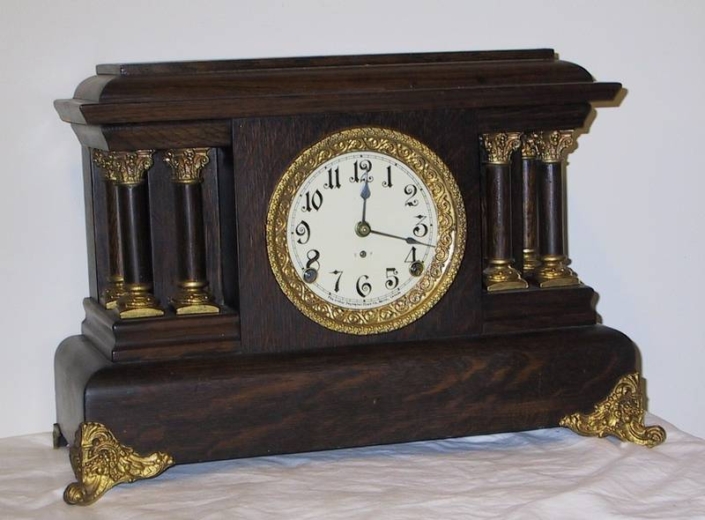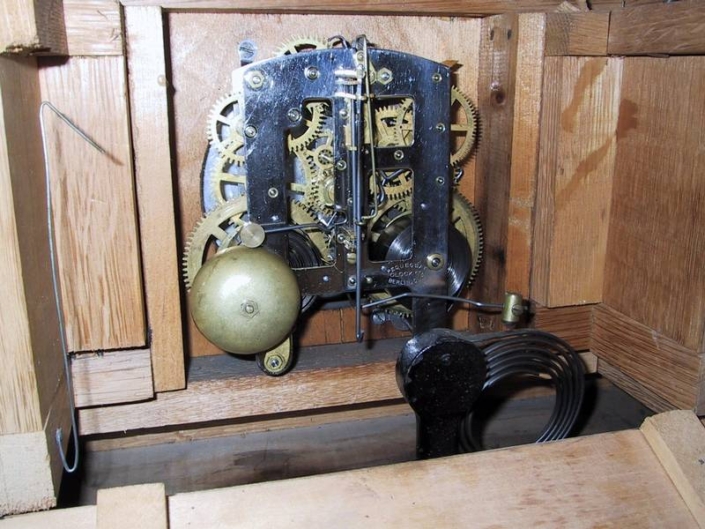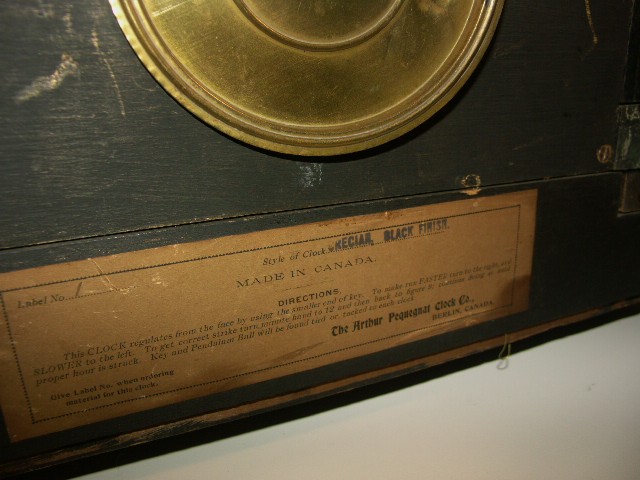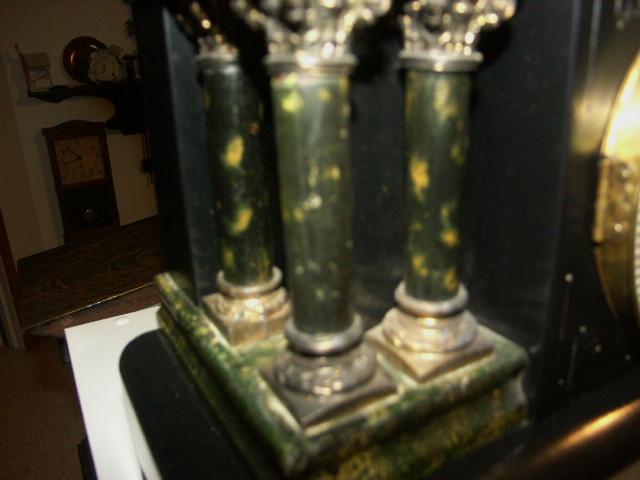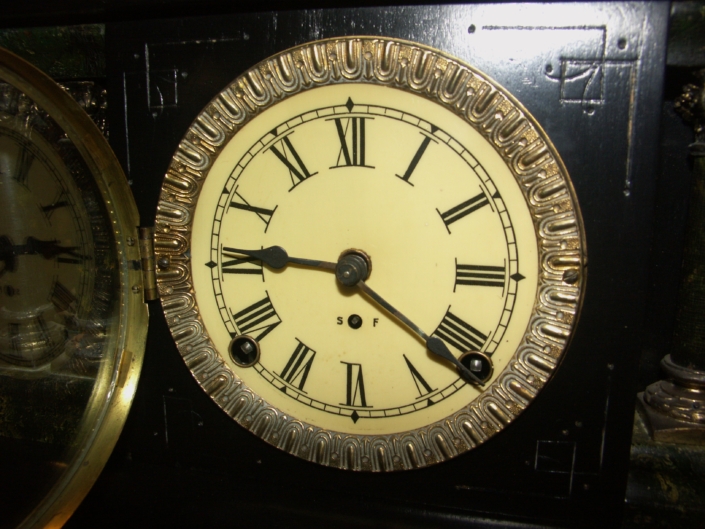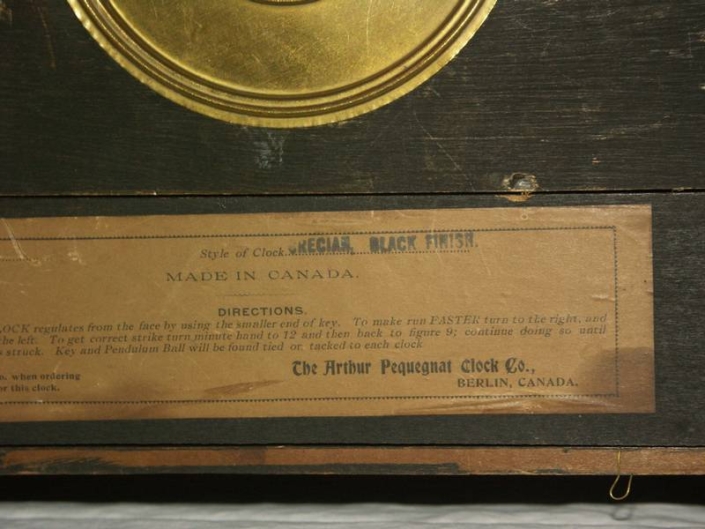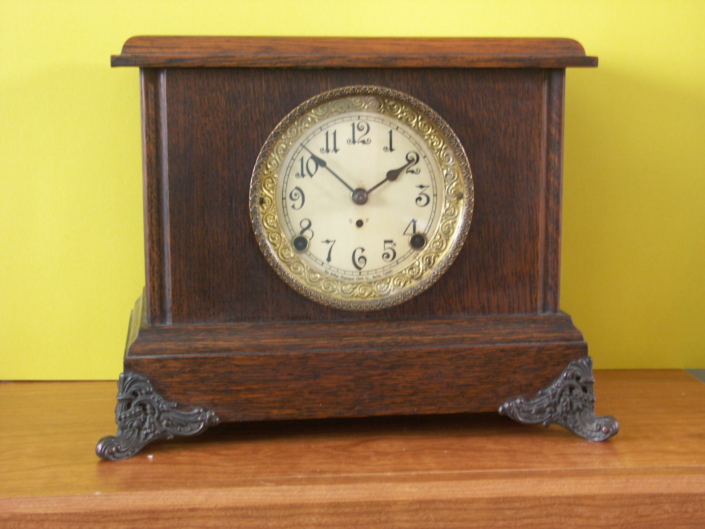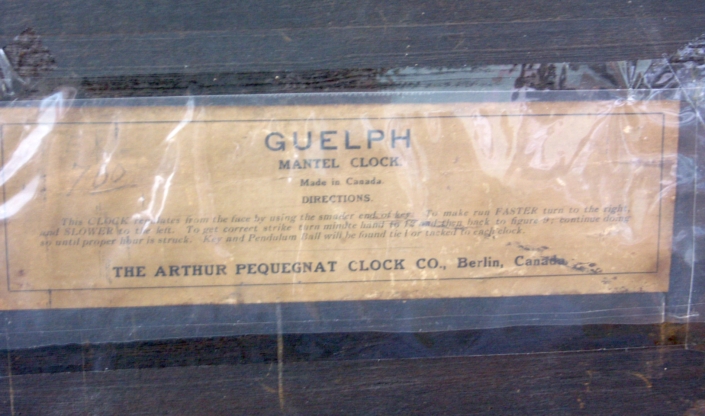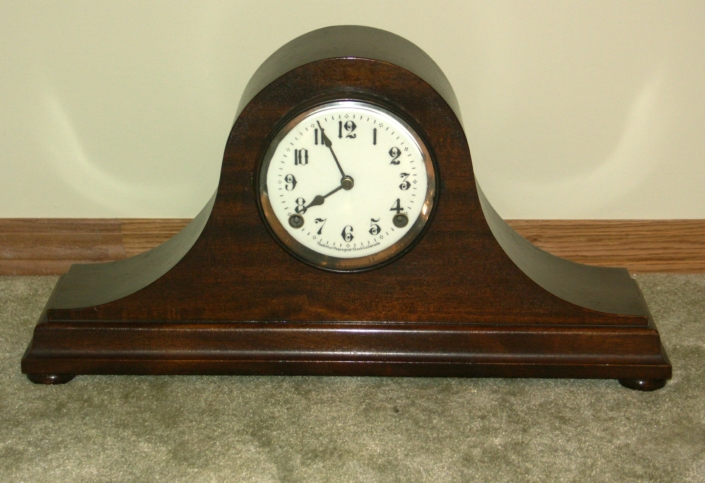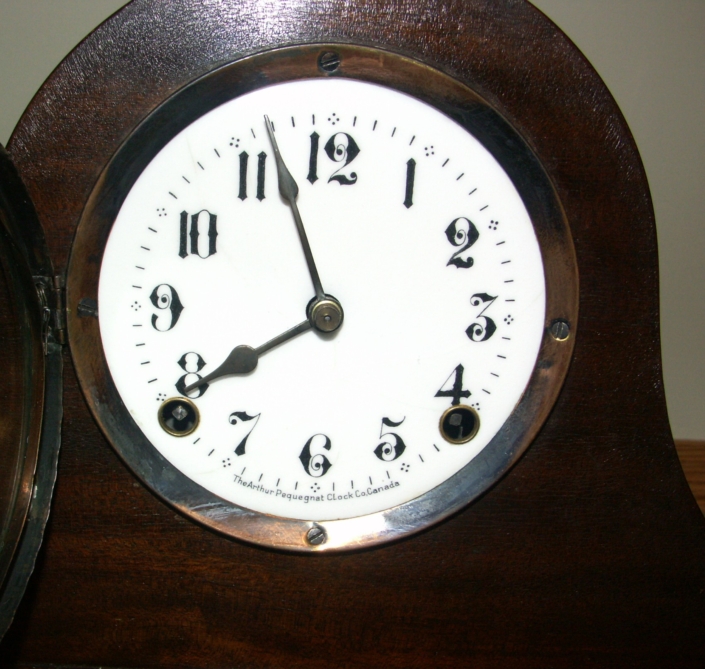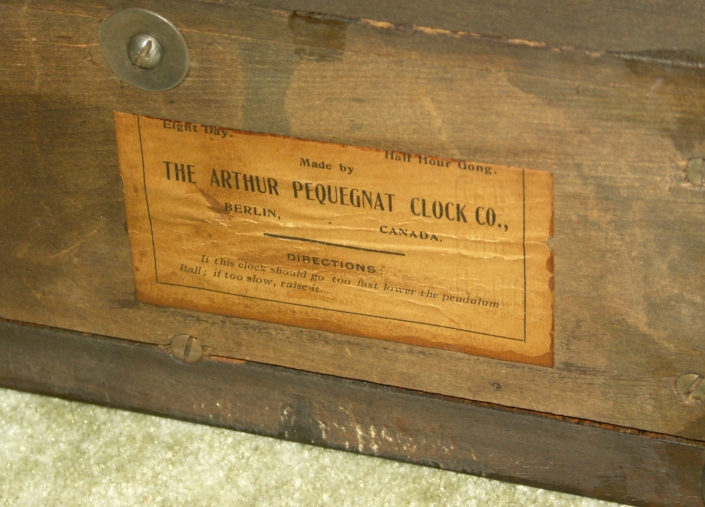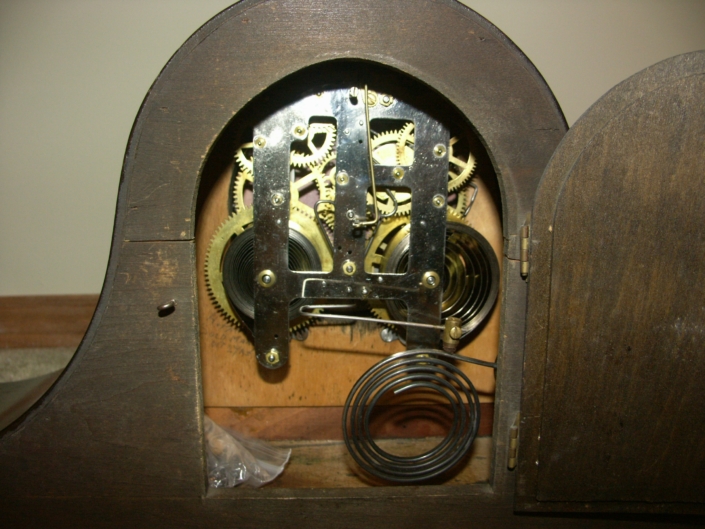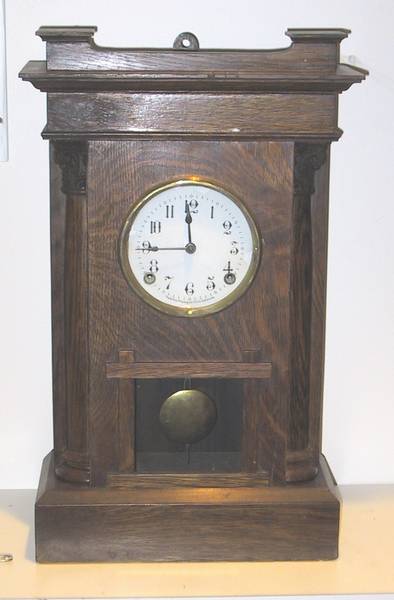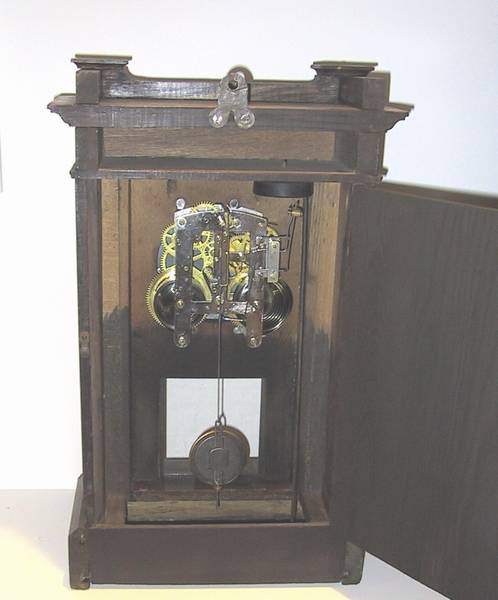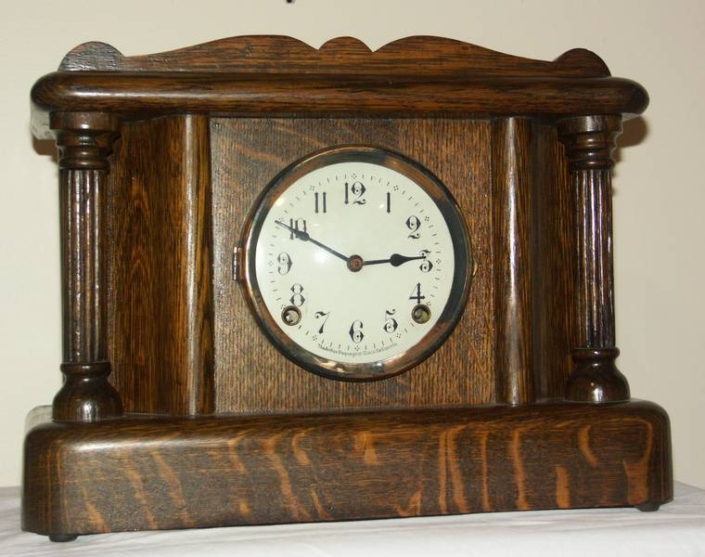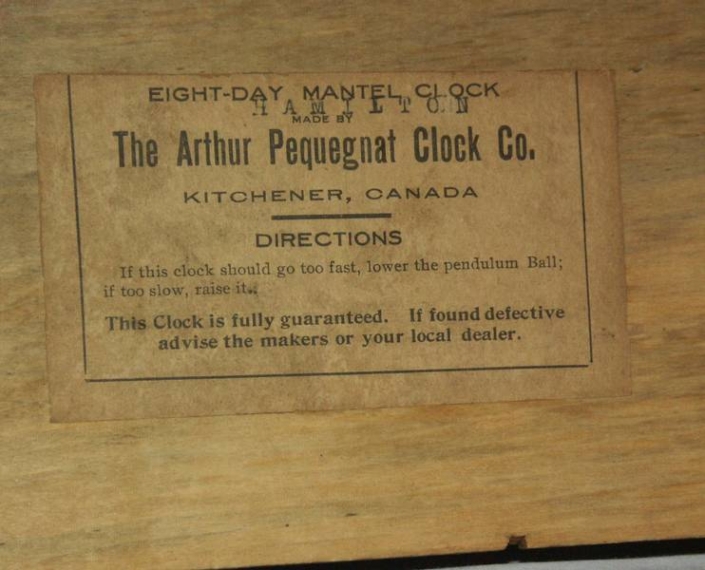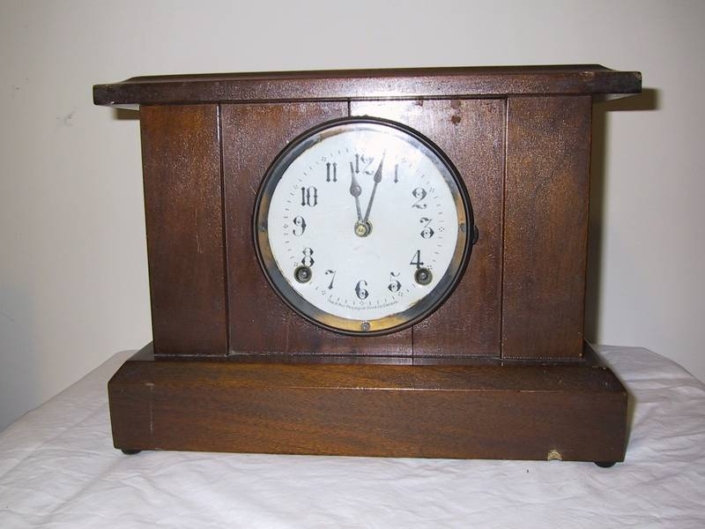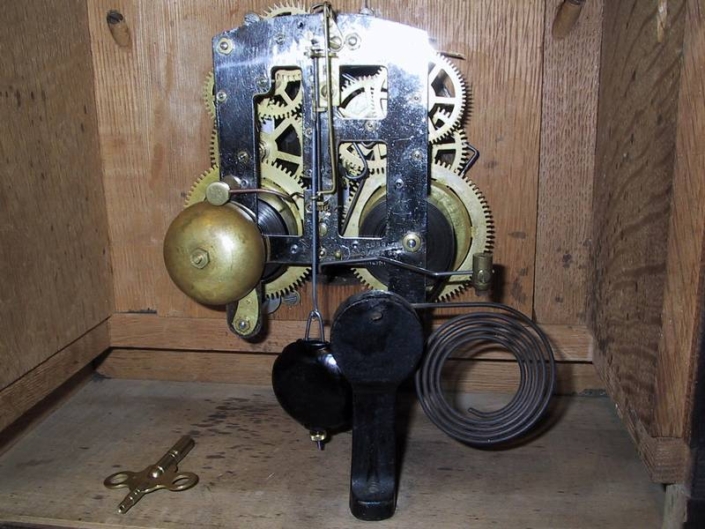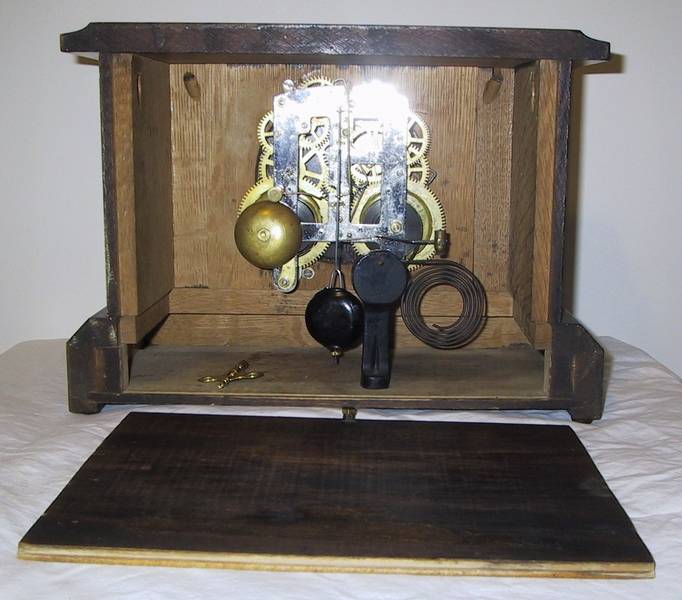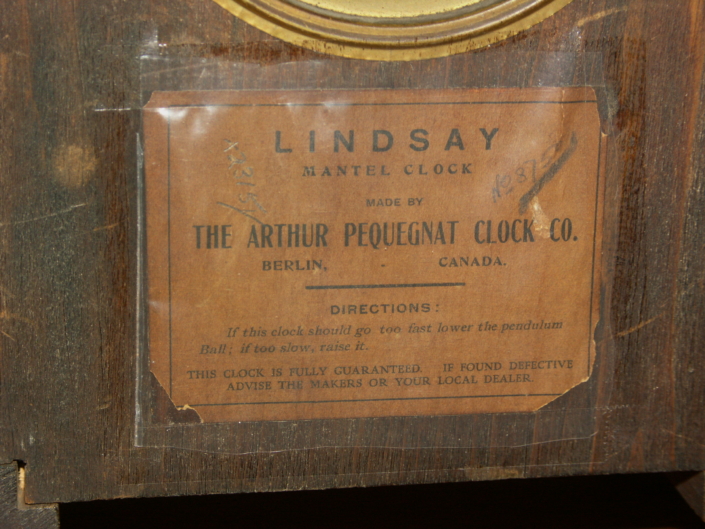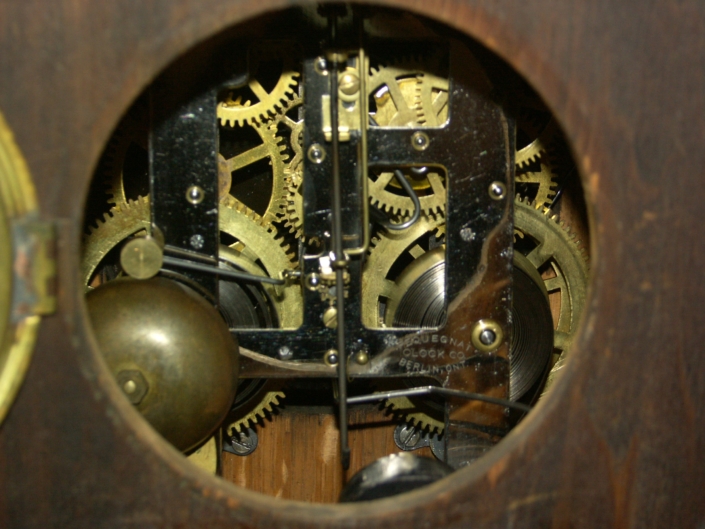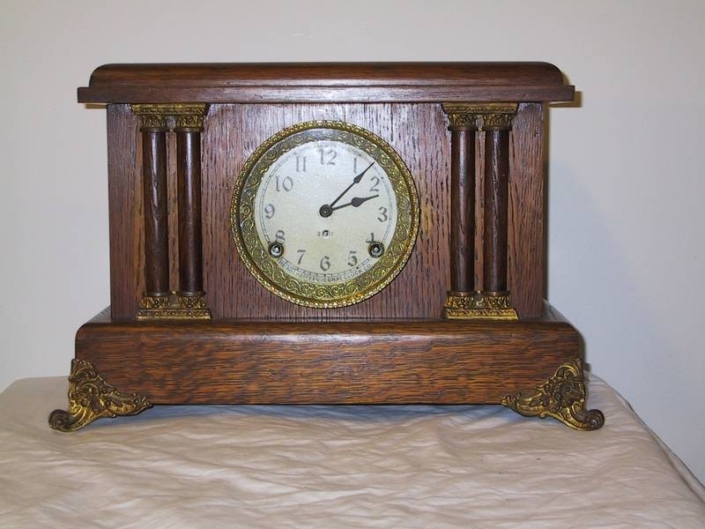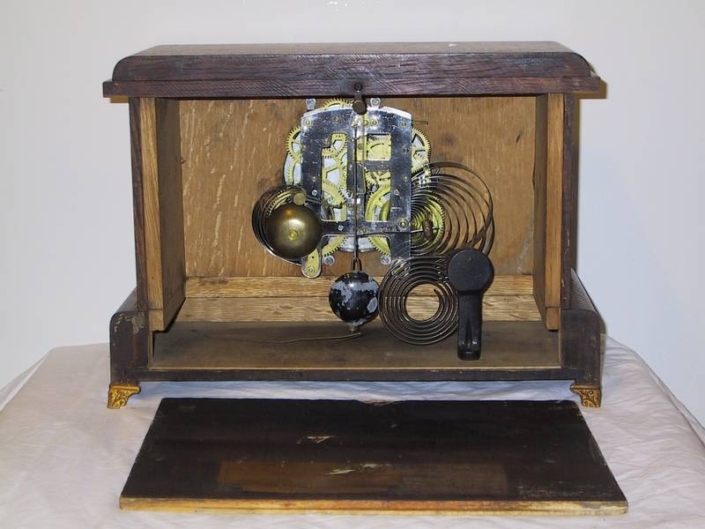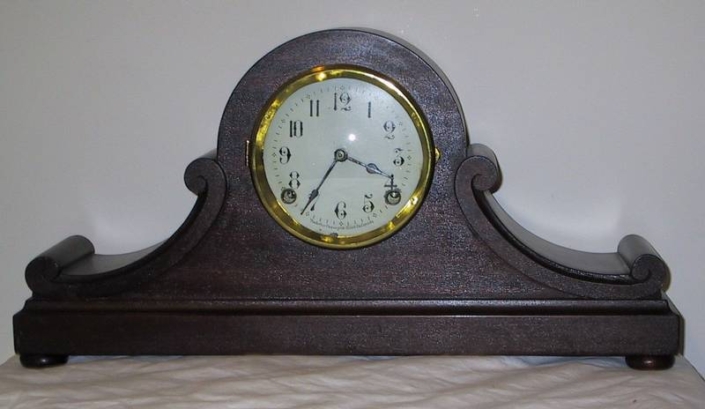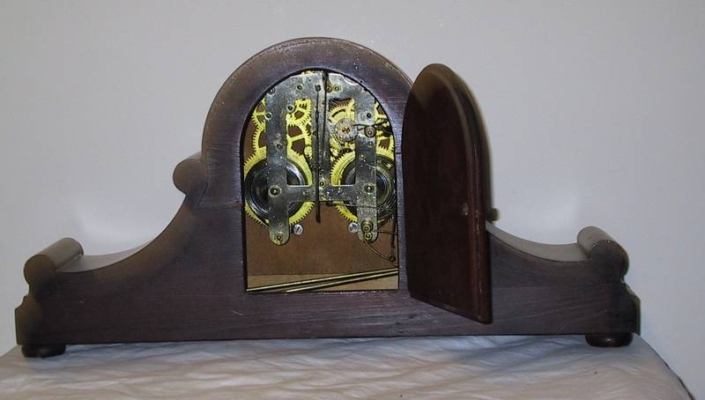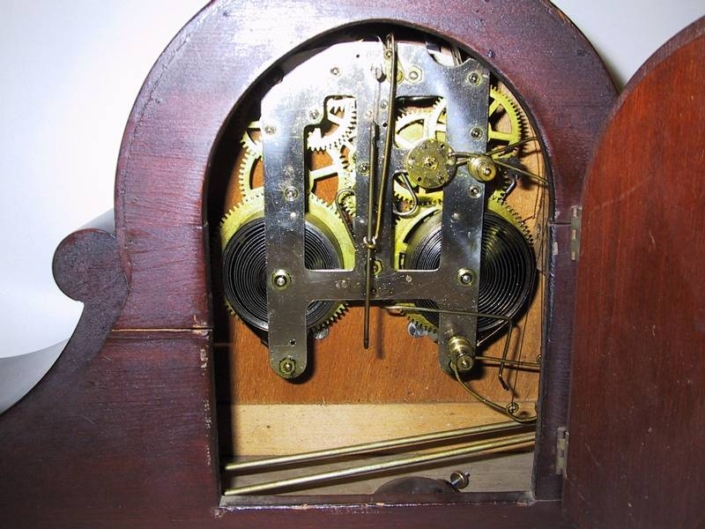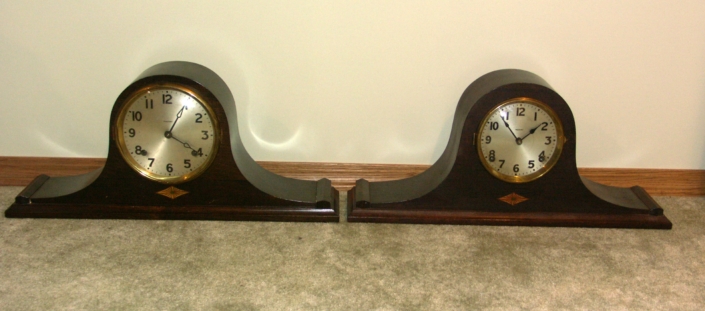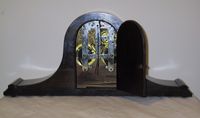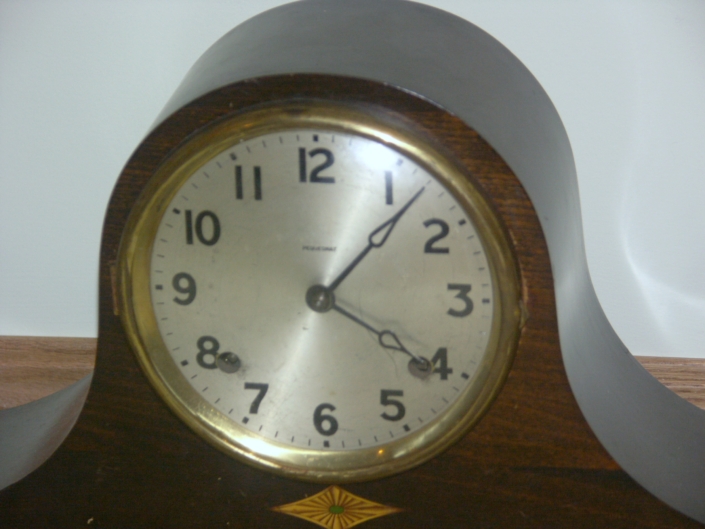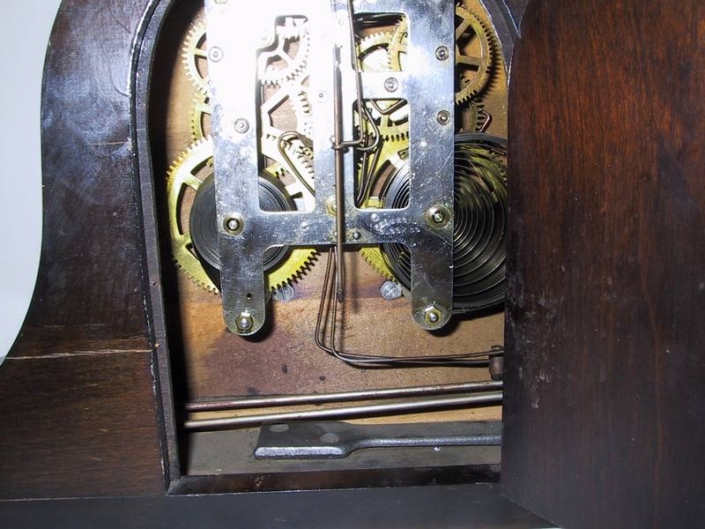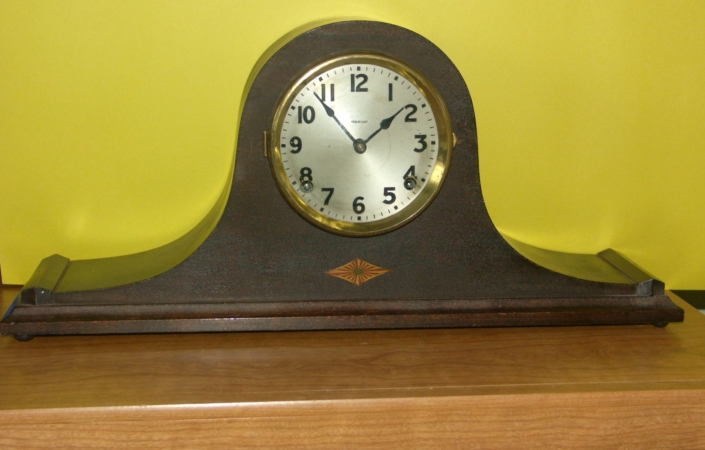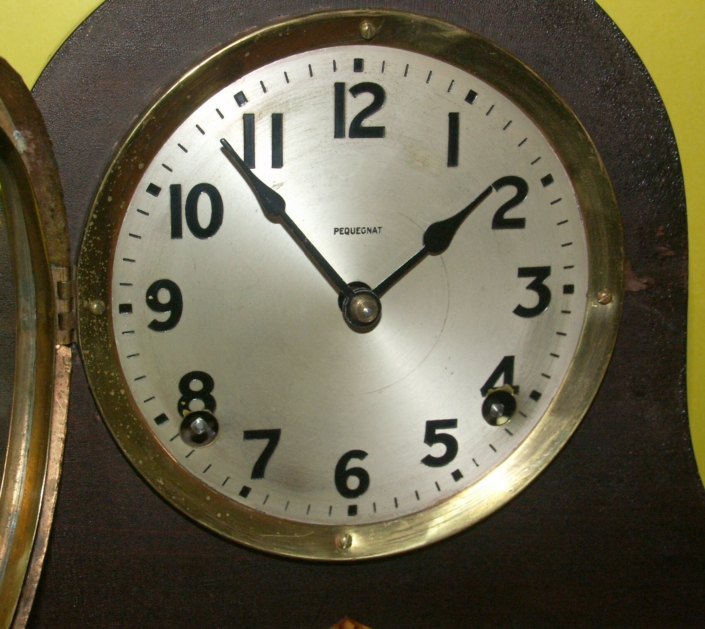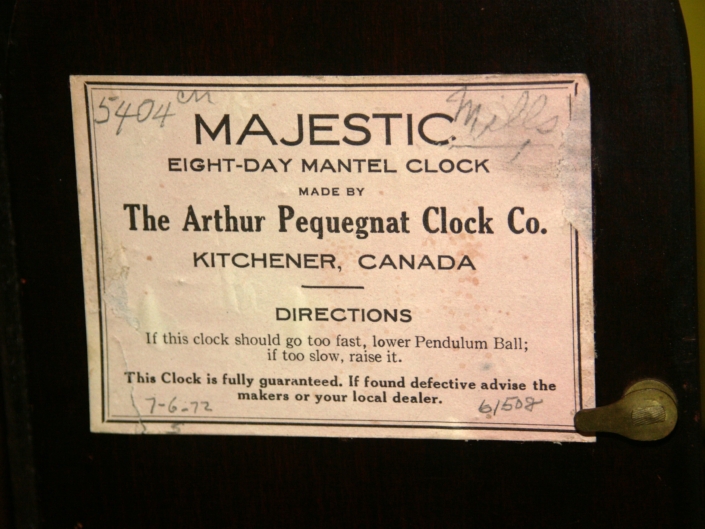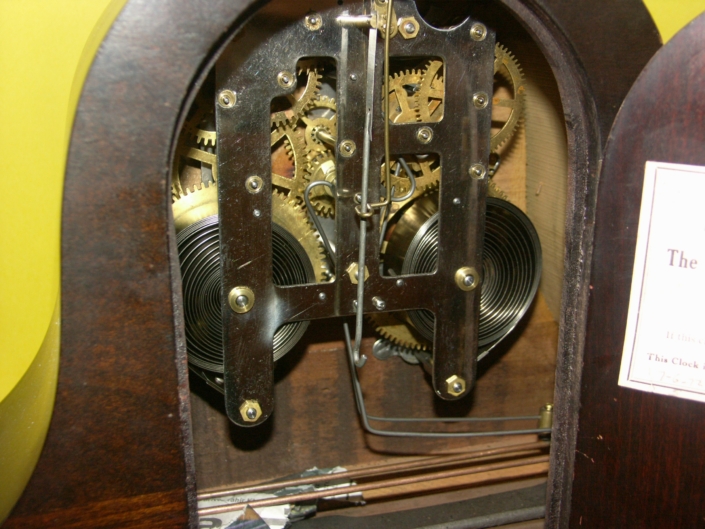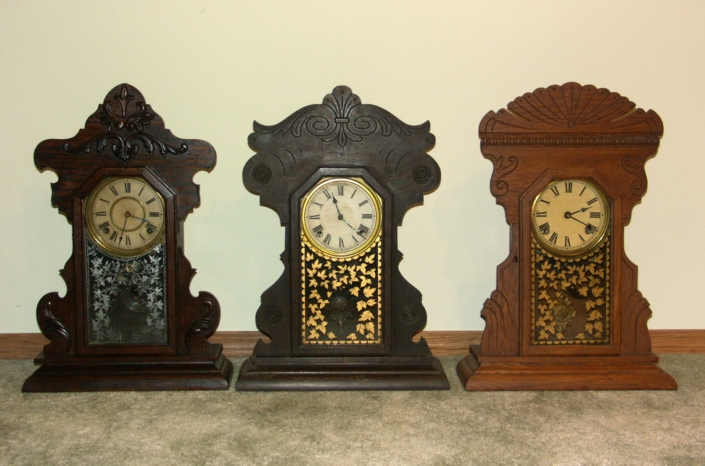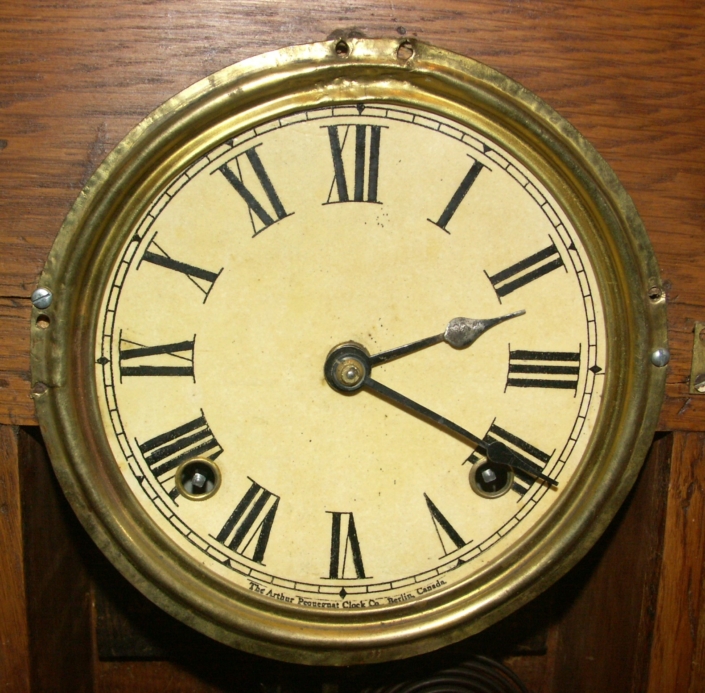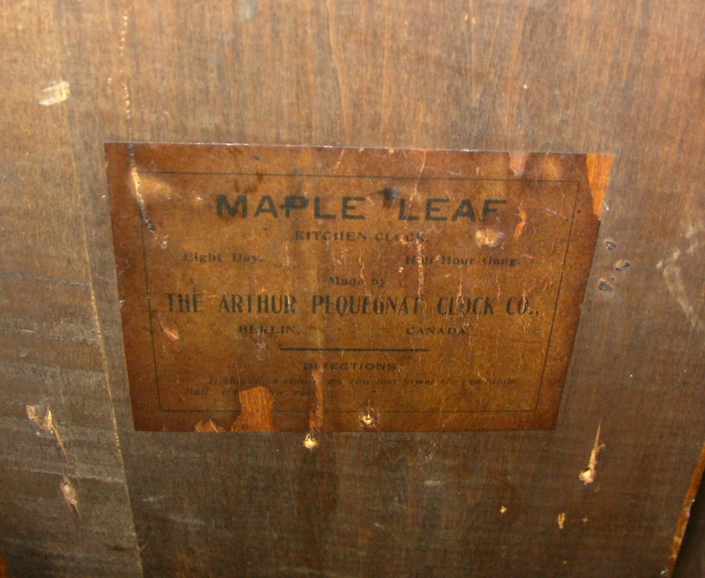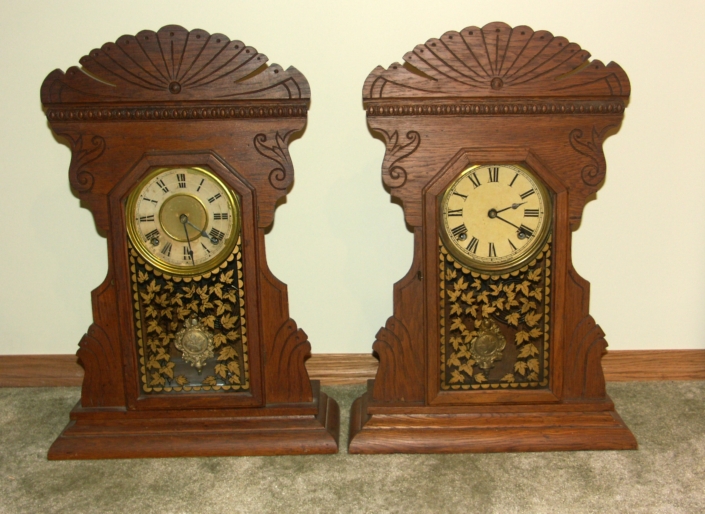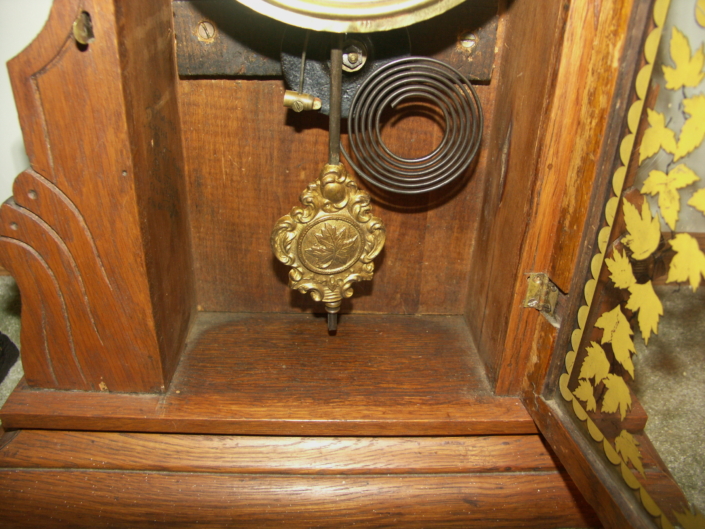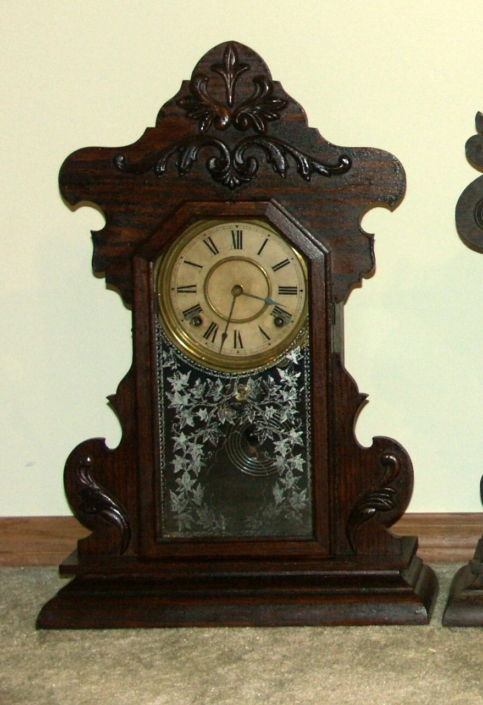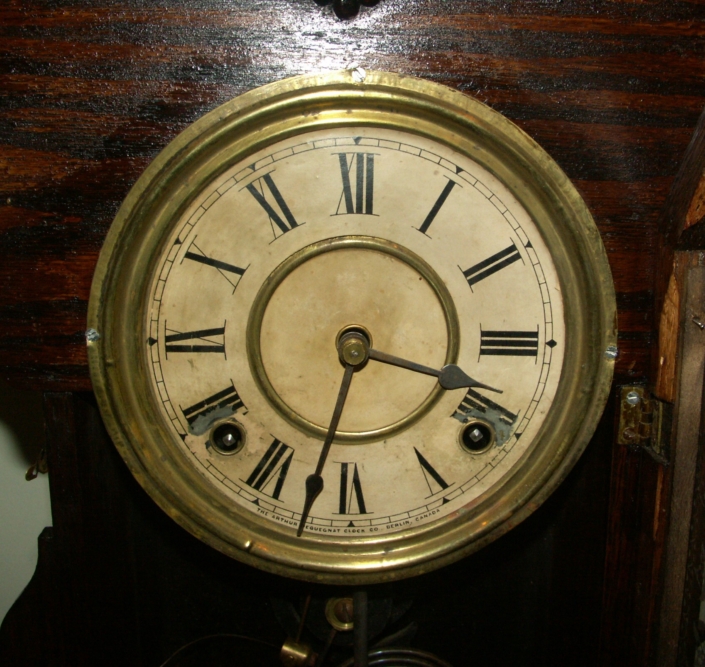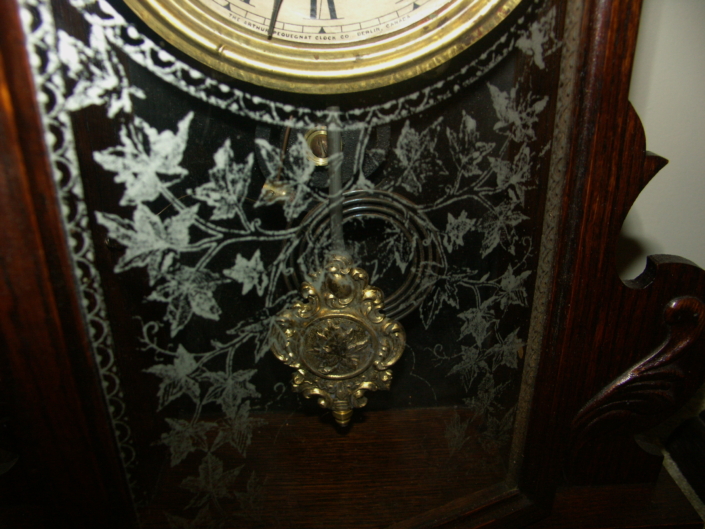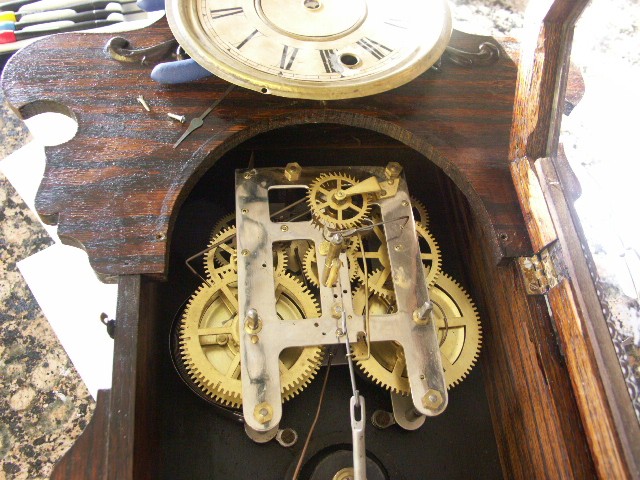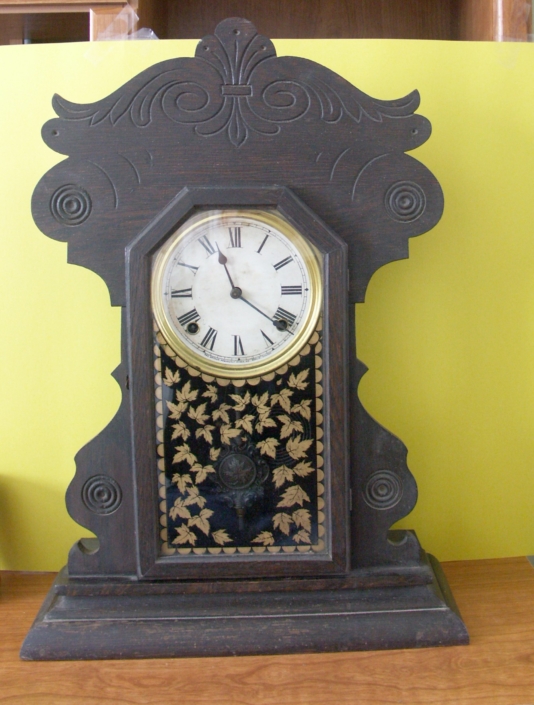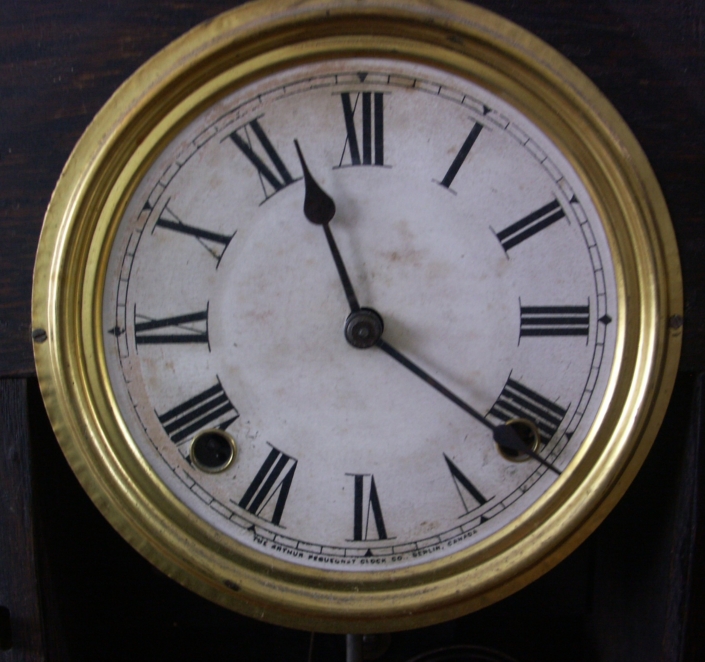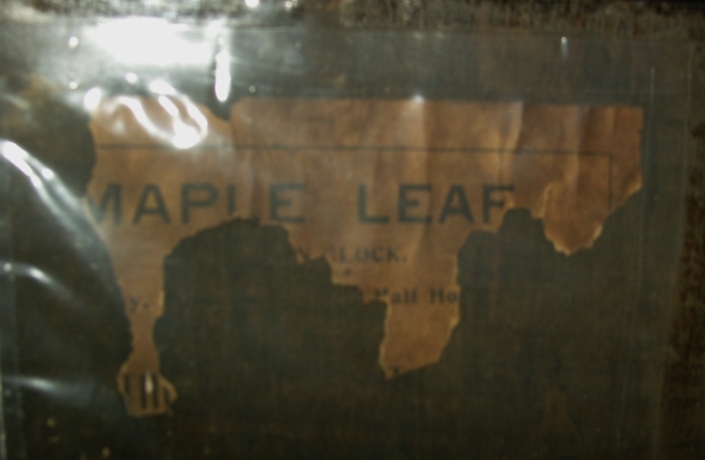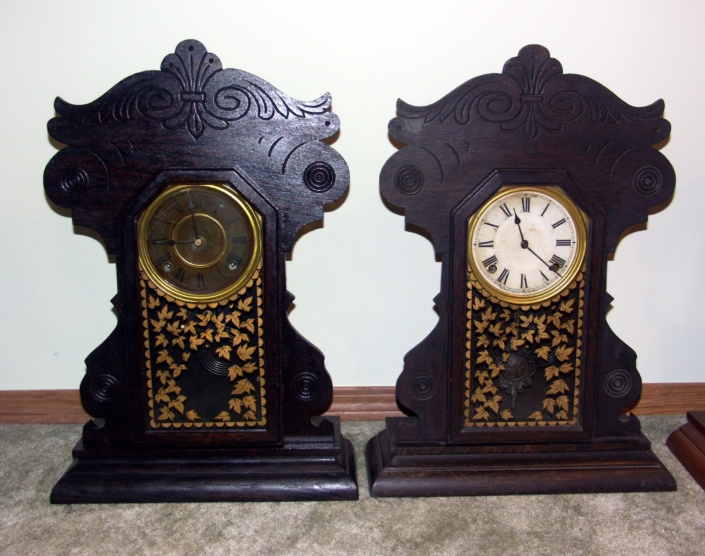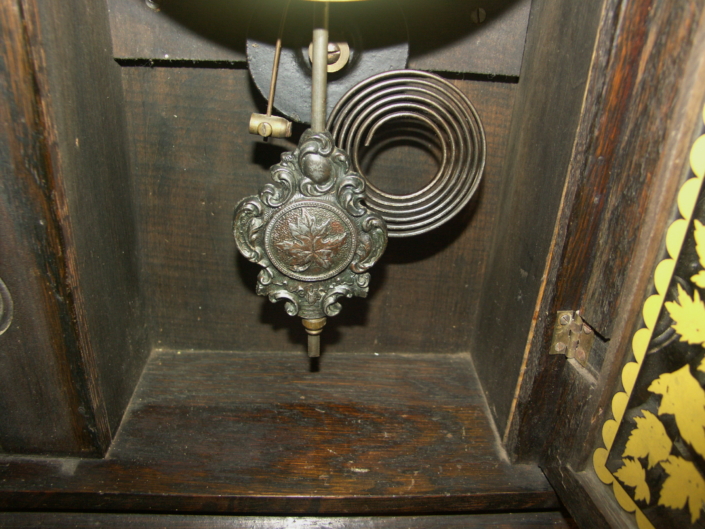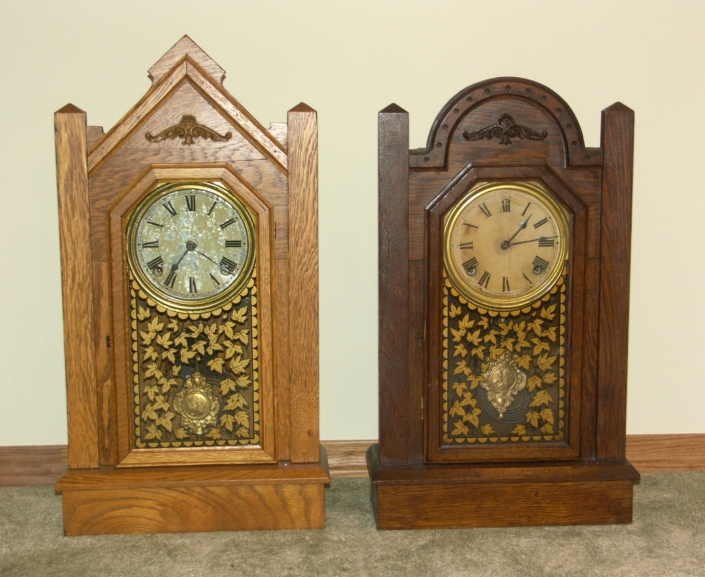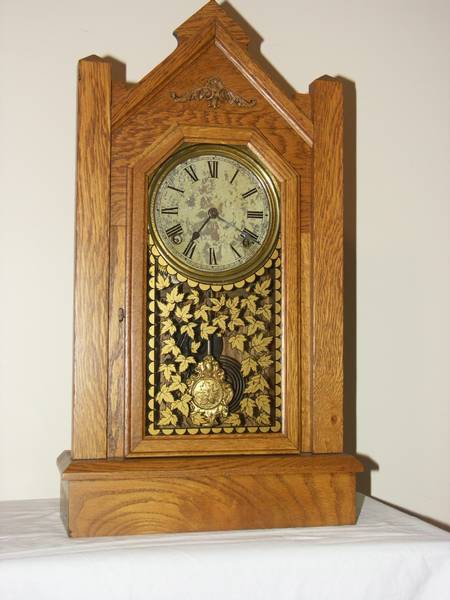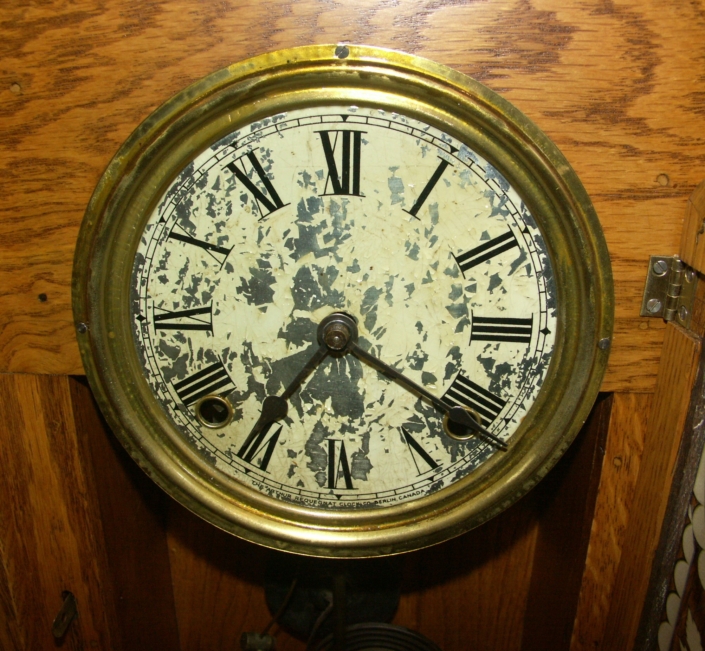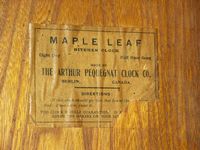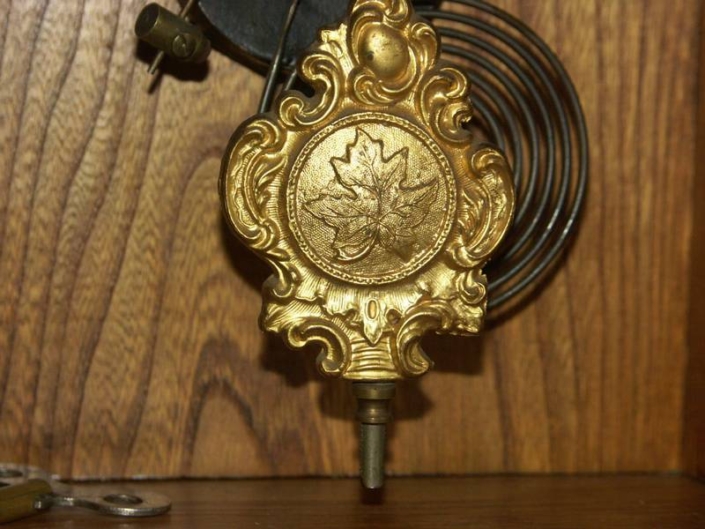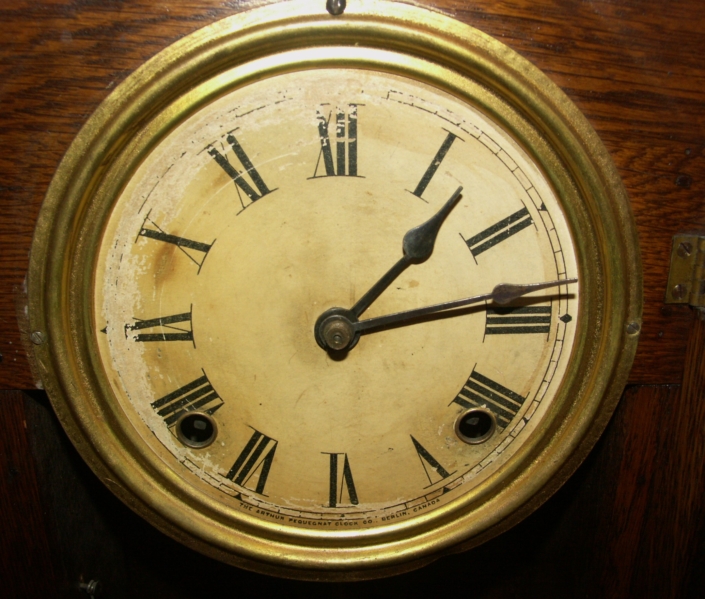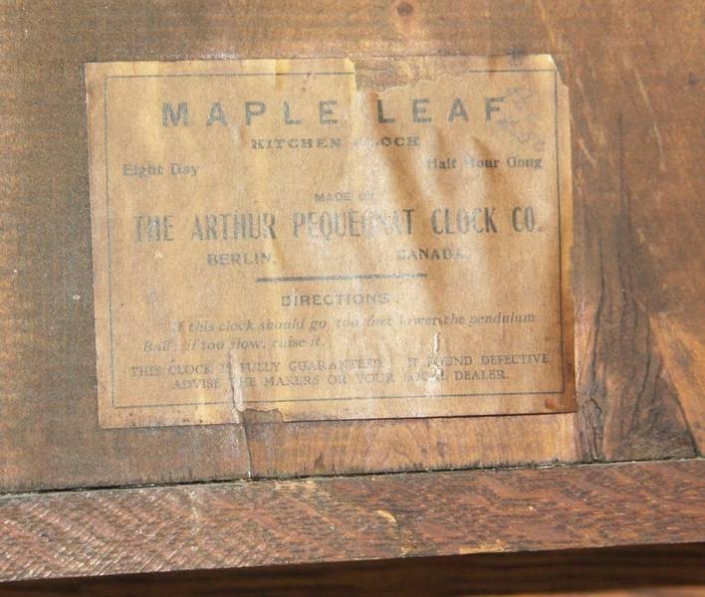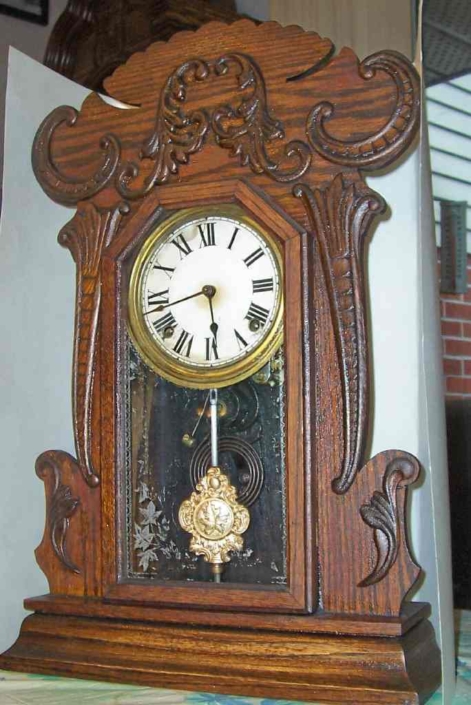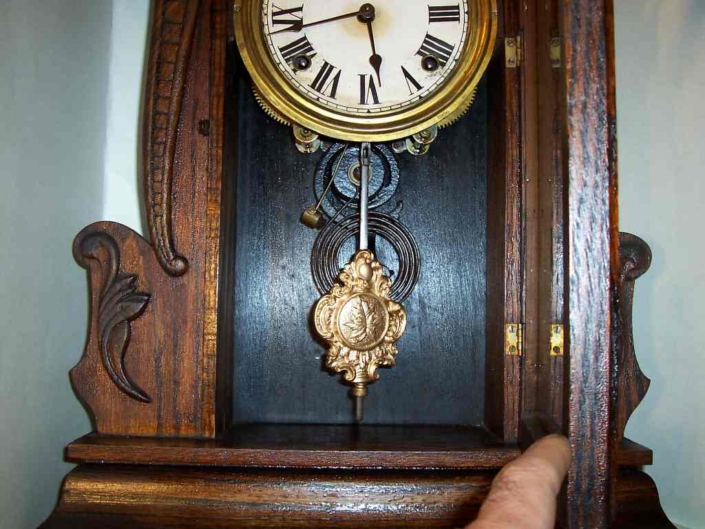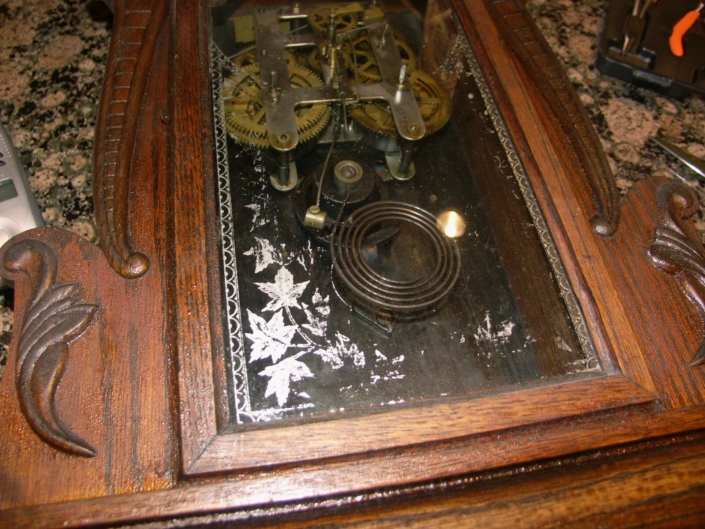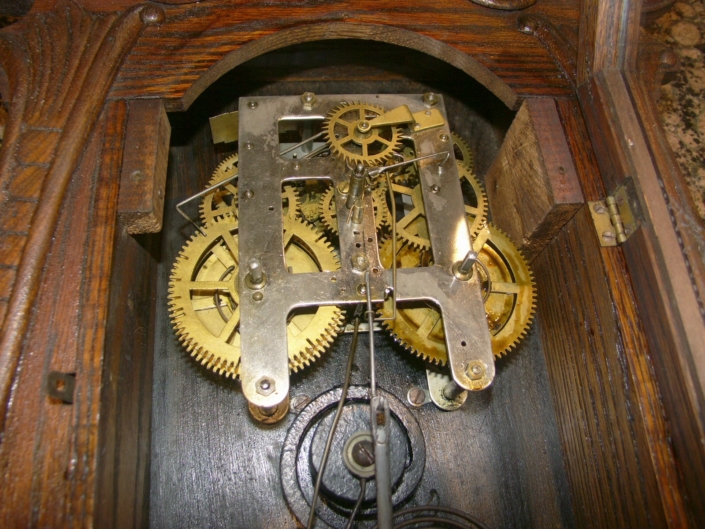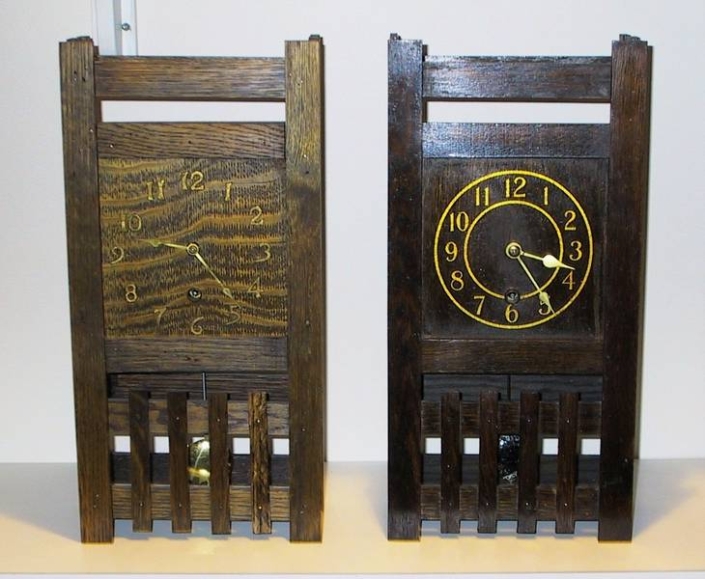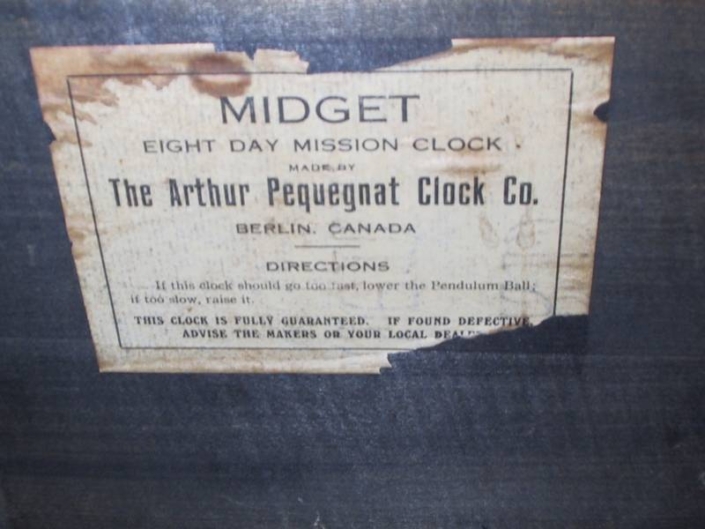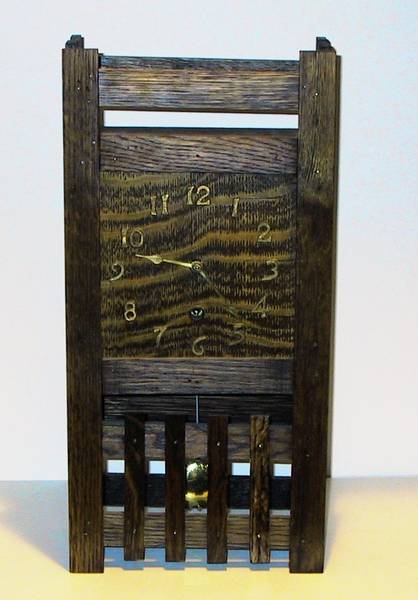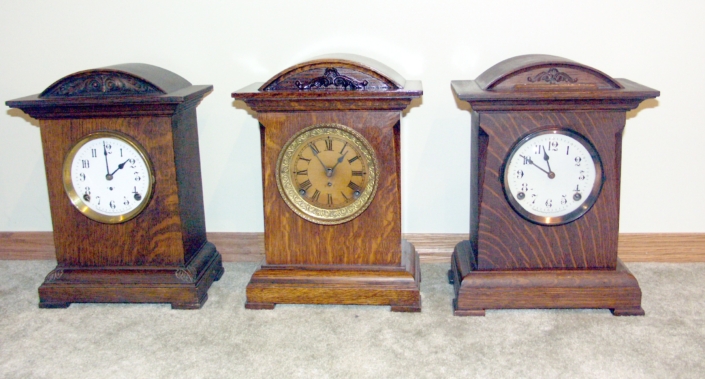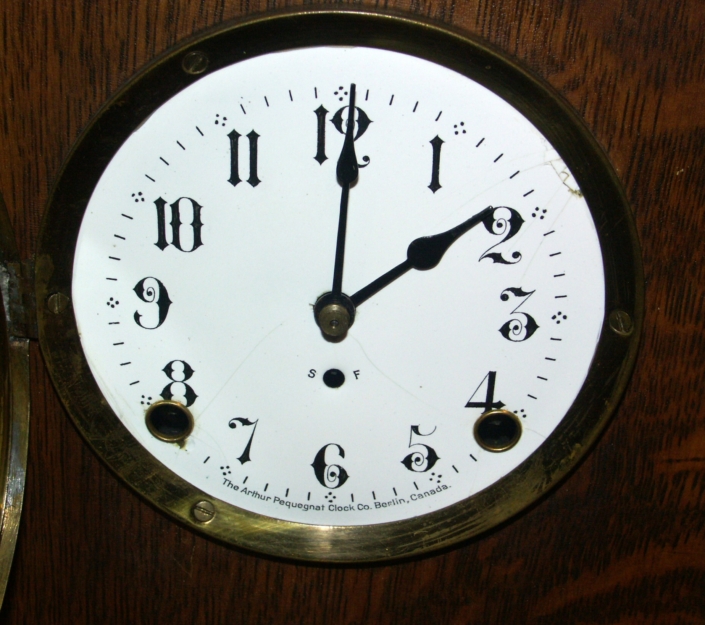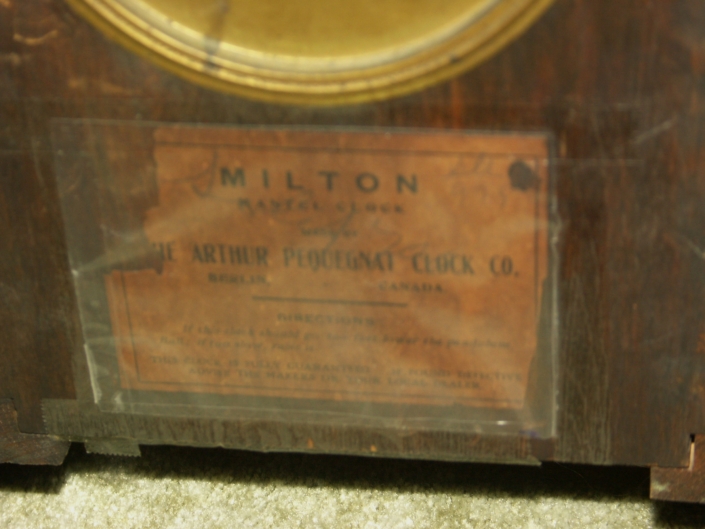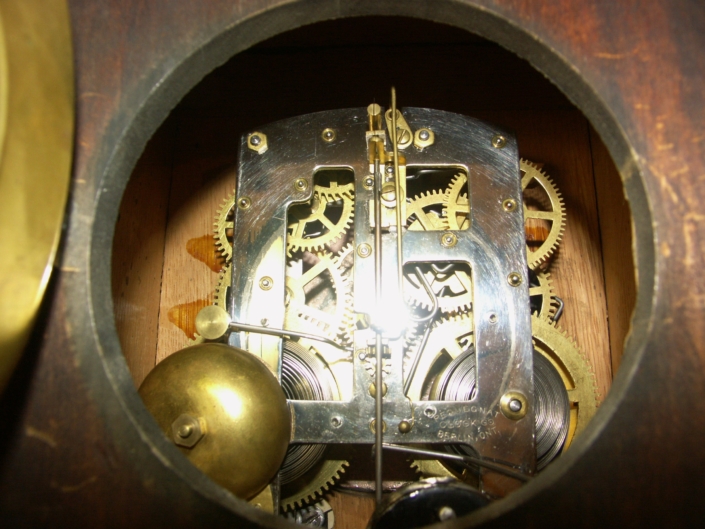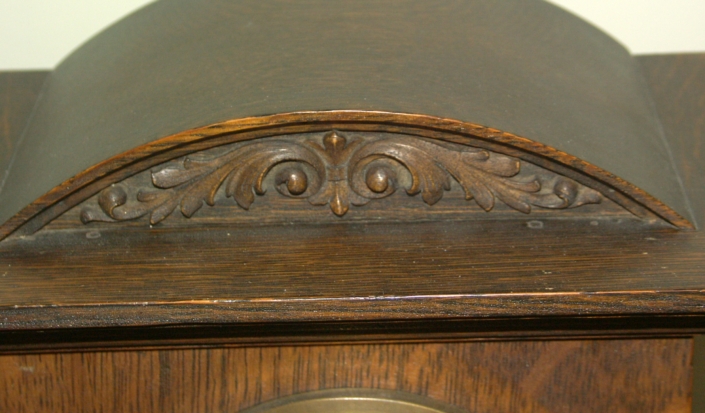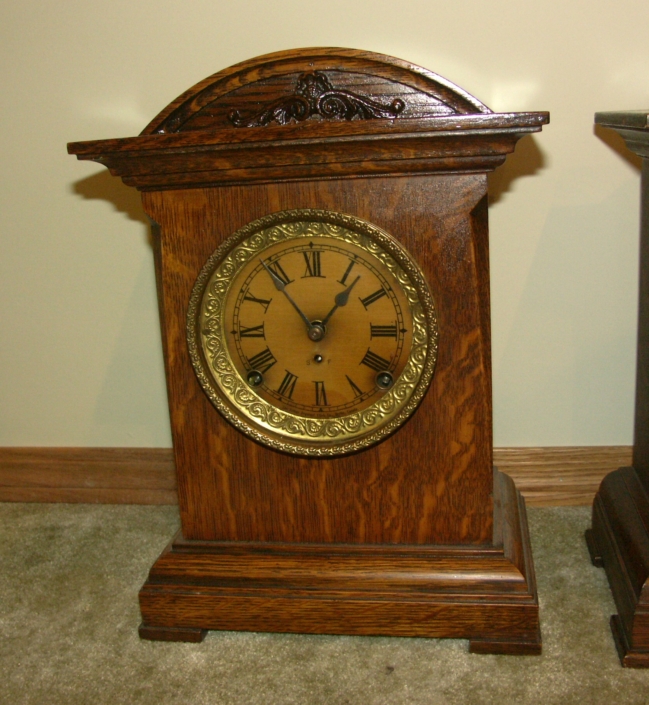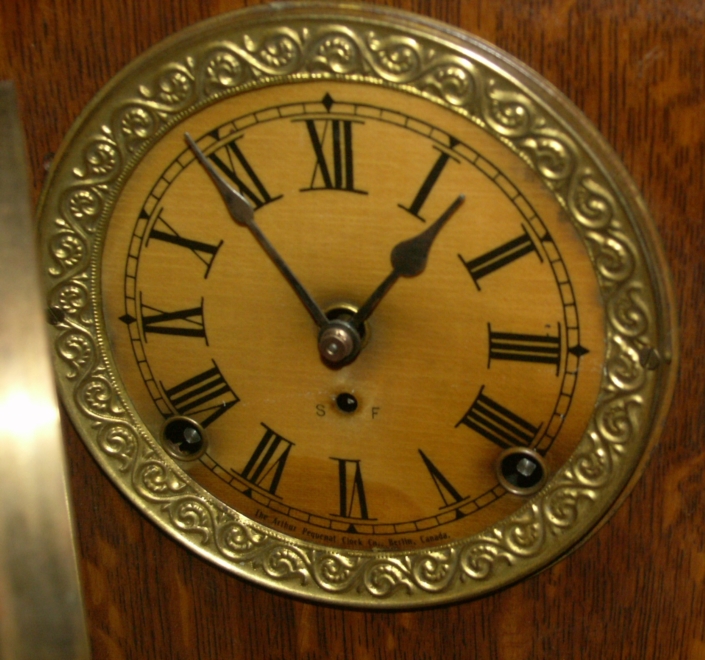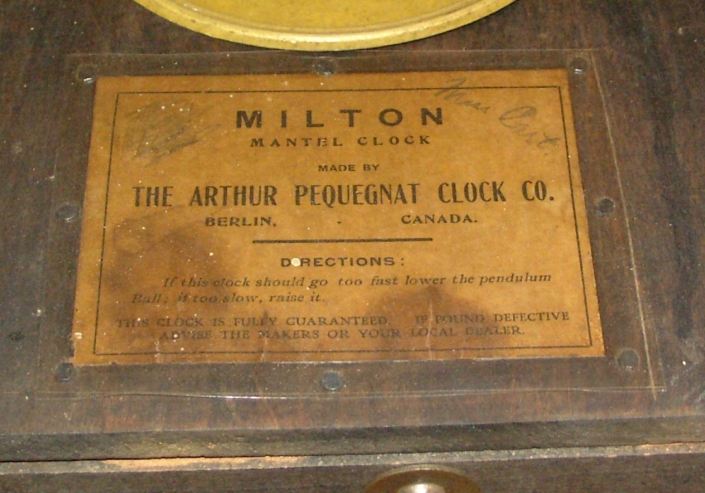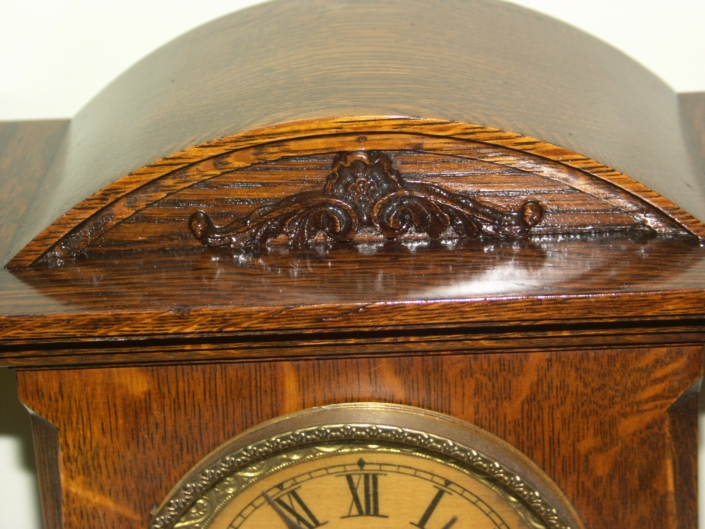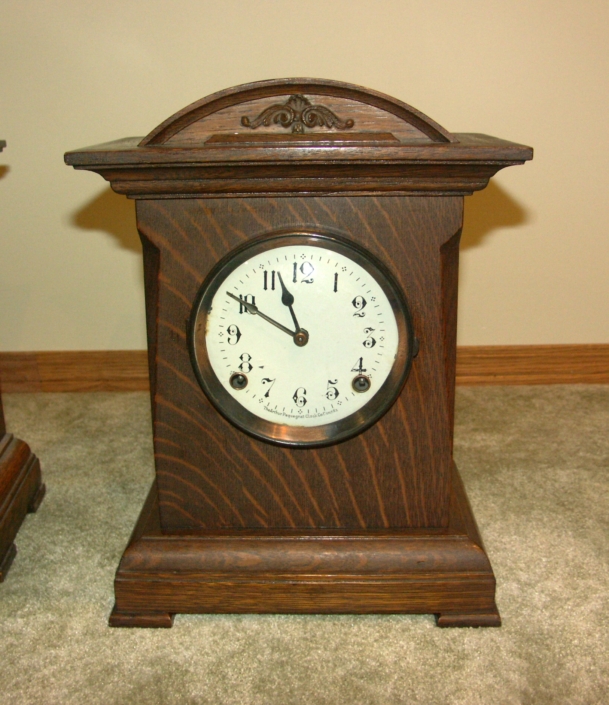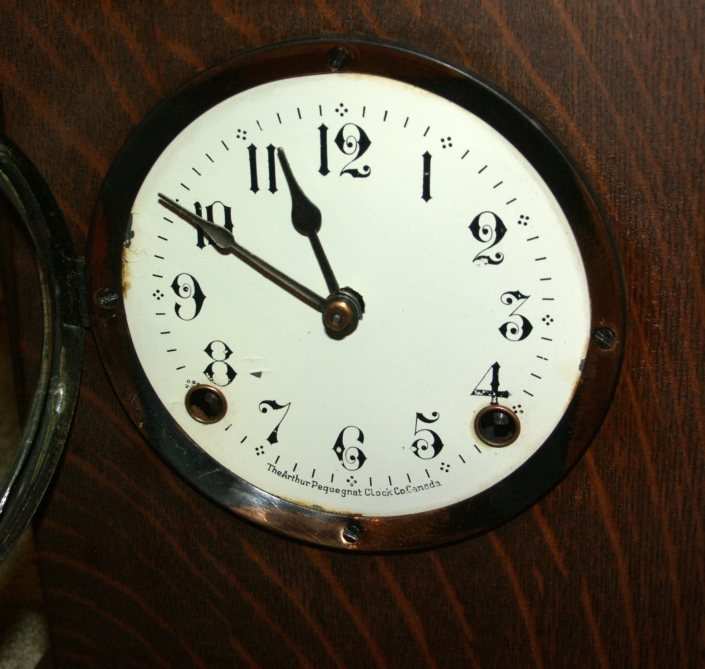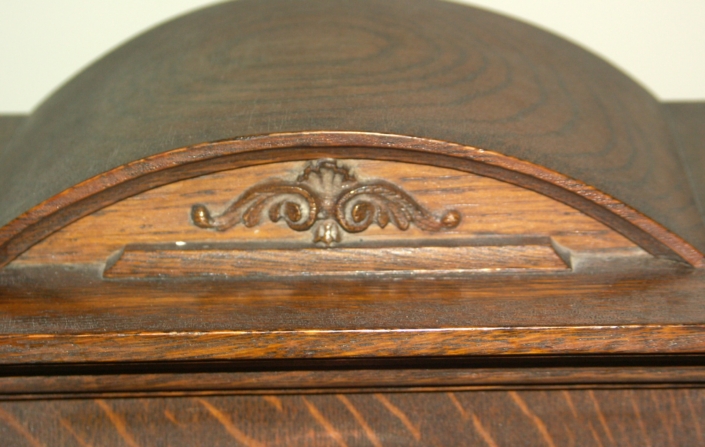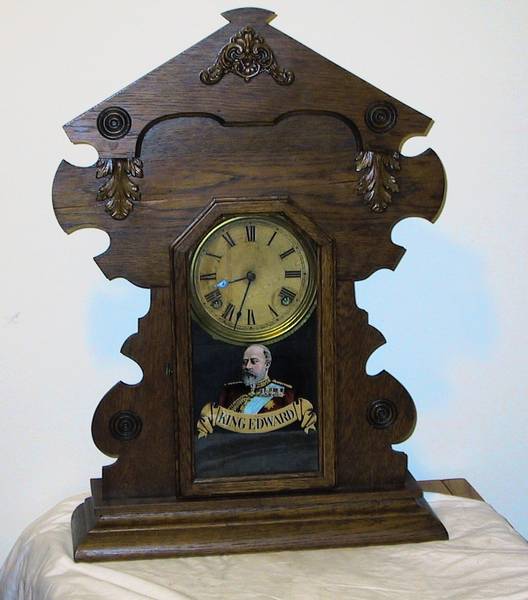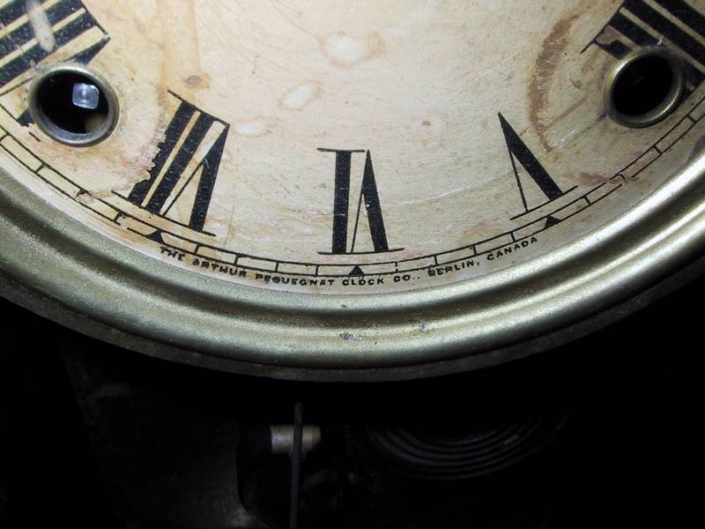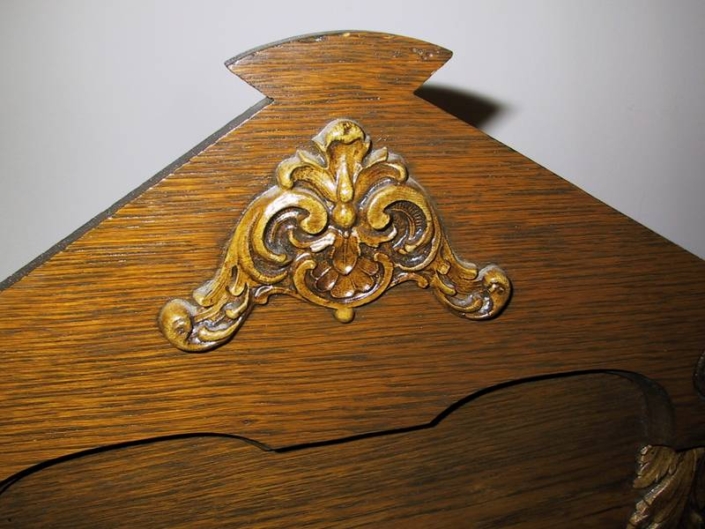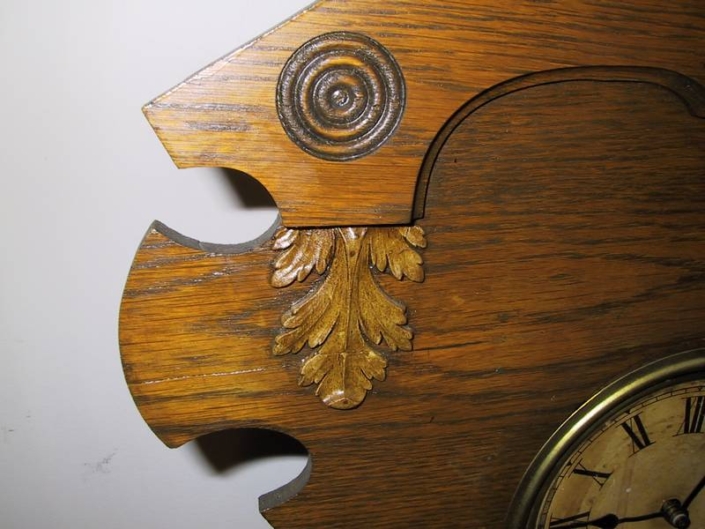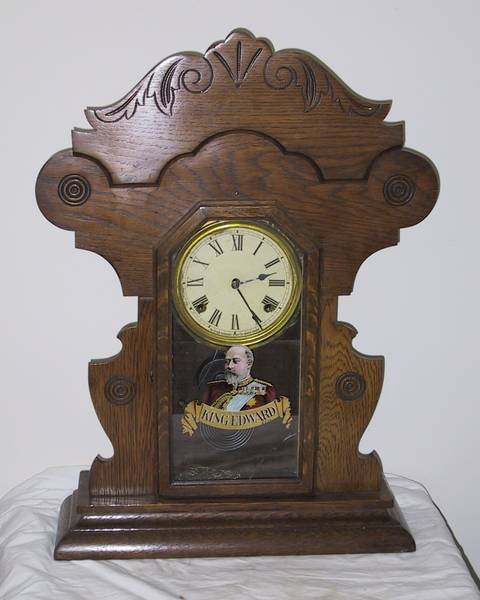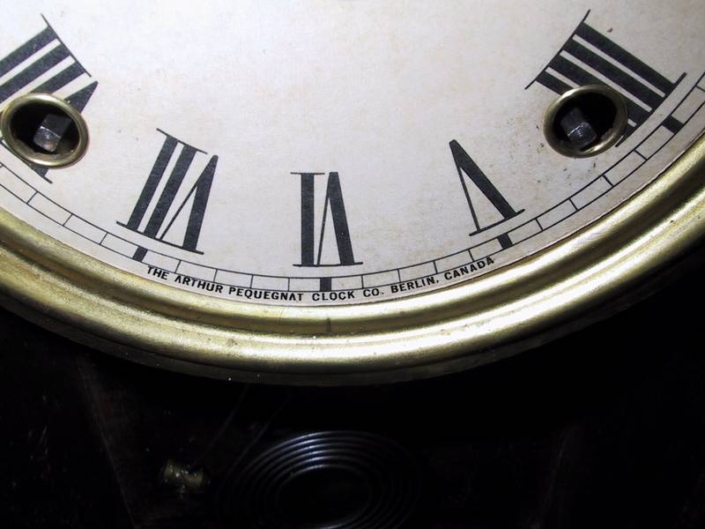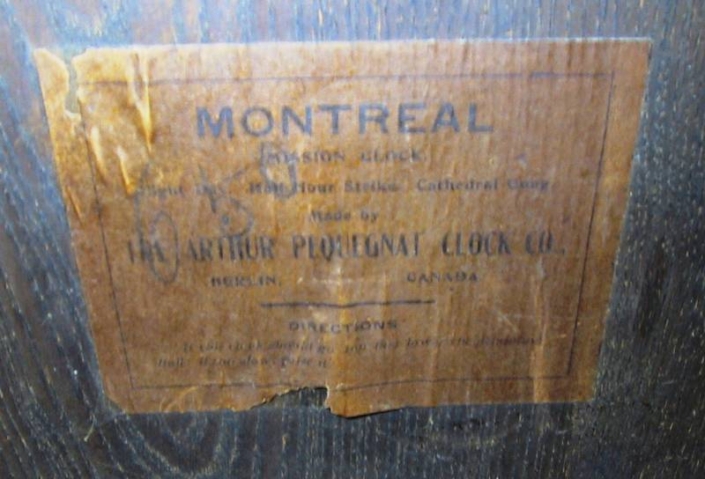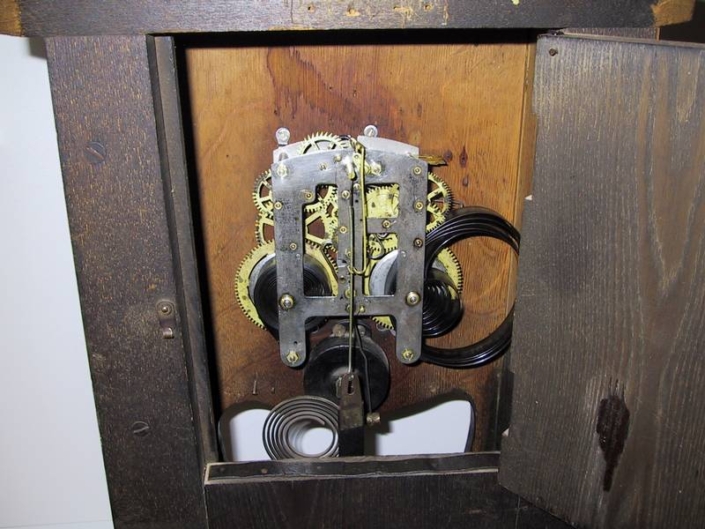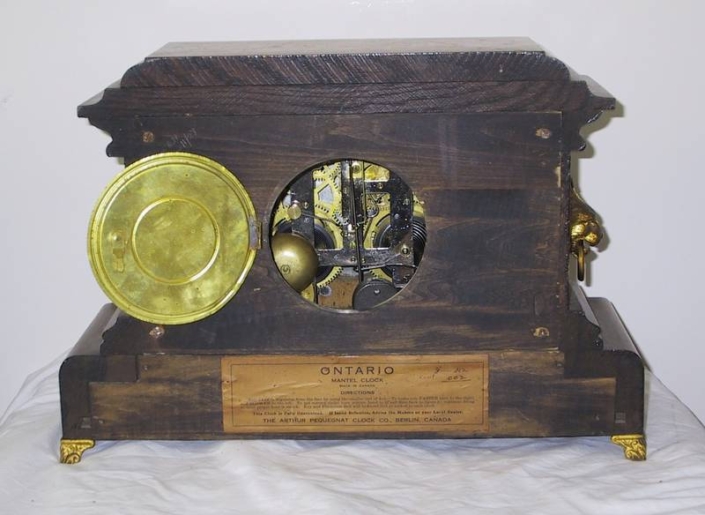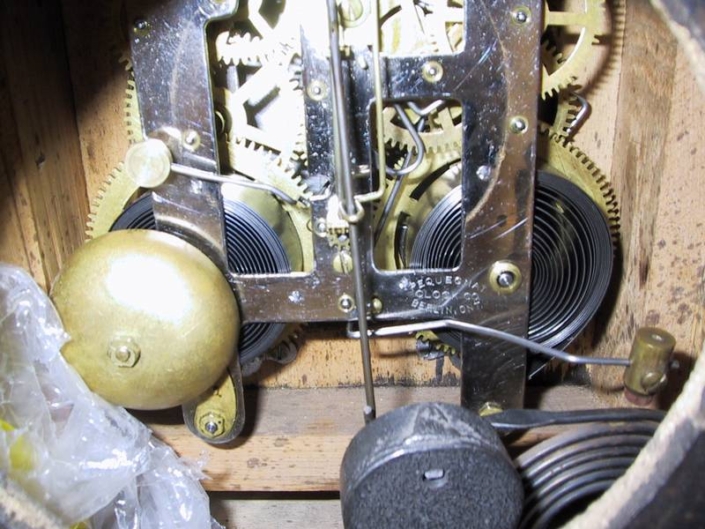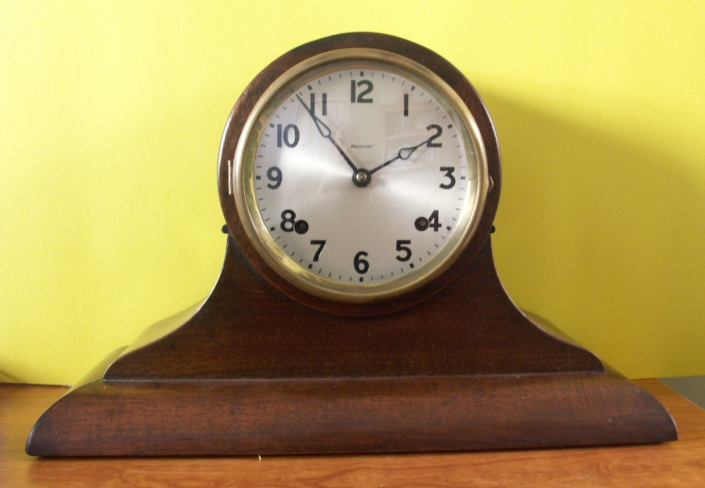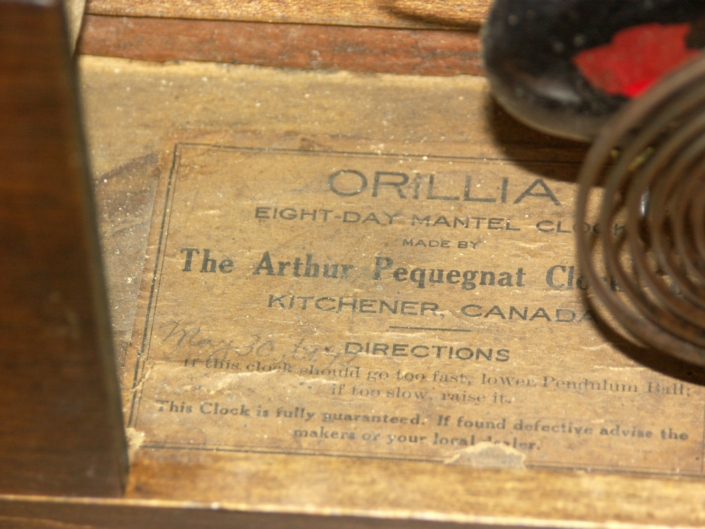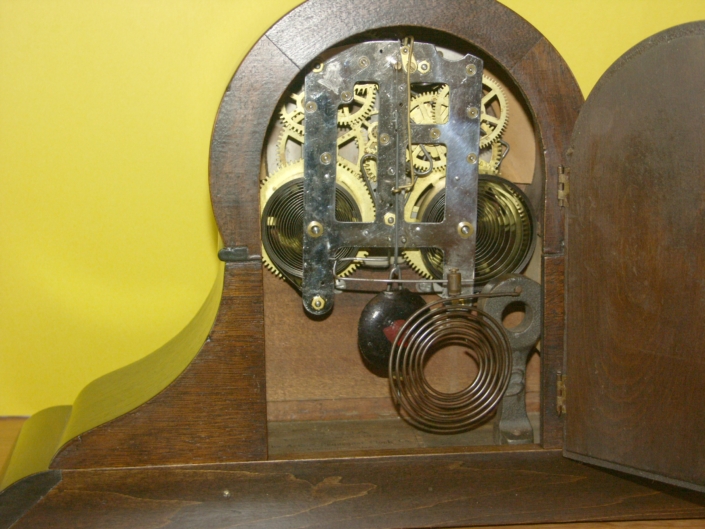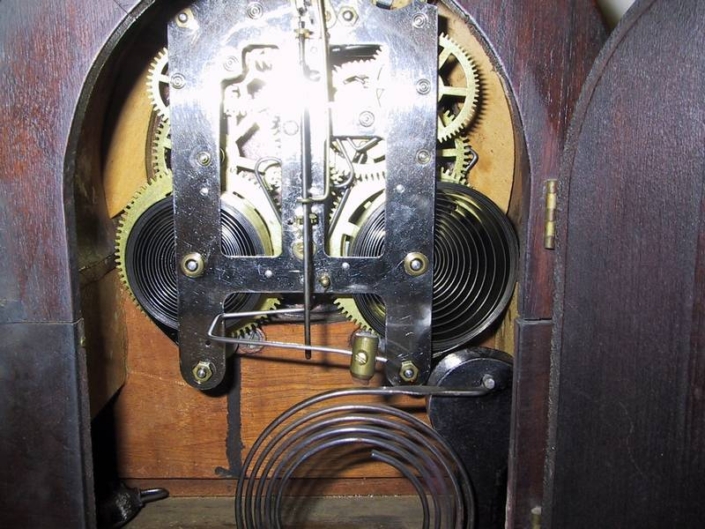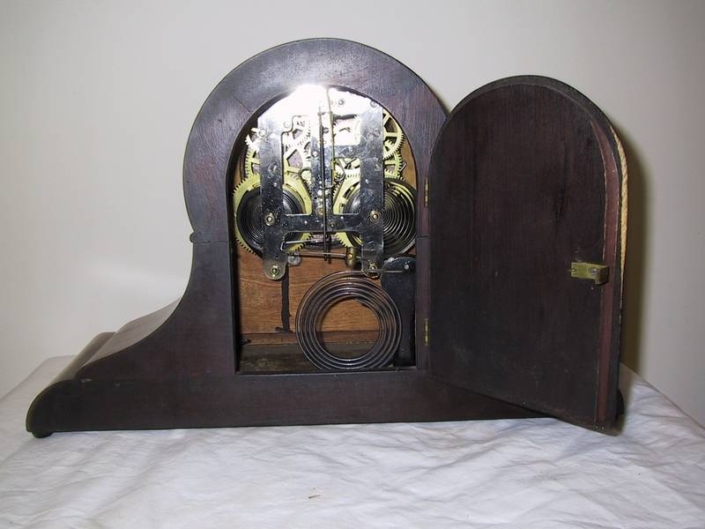Pezuegnat Mantel Clocks “F” to “O”
Grecian
The “Grecian” is probably my favorite Pequegnat mantel clock. It must of been a favorite of Arthur’s also as it was presented in the 1904, 1913, 1918 and 1928 catalogues. The clock below is in a mahogany case with an 8 day movement that gongs the hours and rings the bell on the half. The label, dial and movement are all signed Berlin. The clock measures 11 1/2 inches high, 17 3/4 inches wide and 7 1/4 inches deep.
There were enough of these clocks produced that they show up for sale from time to time. In oak and mahogany they are easier to find, however the black model pictured is very rare. They are also said to of been made in Forest Green, this is also a rare clock and certainly hard to find.
Guelph – First Edition
This clock first appeared in the catalogue supplement to the 1904 Catalogue and again in the catalogue published in 1913. It has an 8 day movement with a gong for the hour and a bell for the half. The clock measures 10 3/4 inches high, 13 inches wide and 7 1/4 inches deep.
This clock is rare and hard to find.
Guelph B
The “Guelph B” is 10 1/4 inches high, by 20 inches wide and is 4 3/4 inches deep. The clock was featured in the 1918 and 1928 catalogues. The label is marked Berlin indicating the clock was probably manufactured in or around 1916.
The clock has an 8 day Time and Strike movement that has a Gong for the hours and half hour.
It’s a clock that comes up for sale from time to time and is not that difficult to find.
Hamilton – Tall
This oak clock has an 8 day time and strike movement on a gong. It was featured only in the 1913 catalogue as was it’s almost twin brother the “St Thomas”. The only difference was that the “St Thomas” had a mission dial while the “Hamilton Tall” had the dial pan. In 1928 the new model of the “Hamilton” came out and it was in the style of the more traditional Pequegnat mantel clocks, that is more wide than high and with columns. The “Hamilton Tall” is 21 1/2 inches tall and 13 inches wide.
It’s a very difficult clock to find.
Hamilton – Wide
The “Hamilton (Wide)” first showed up in the 1928 catalogue. It’s a completely different model than the “Hamilton (Tall)” that appeared in the 1913 catalogue. This beautiful oak clock has an 8 day movement that gongs on the half hour and strikes the hours on tuned rods. The clock measures 11 1/2 inches wide and 15 inches high.
It’s a nice clock that is difficult to find.
Jewel – Ornate Sash
The Jewel and Bijou were sold as a pair to the trade with a box containing one of each. The golden oak clock below is 13 1/4 inches wide, 10 inches tall and 6 1/2 inches wide. The 8 Day Time and Strike movement that gongs on the hour and rings the bell on the half. The clock has a Berlin signed movement and dial.
This earlier model, with the ornate sash, is harder to get than the more common one with a plain sash. The clock has no label.
Lindsay
London
London B
The “London B” was featured in the 1918 and 1928 Pequegnat Catalogues. It has an 8 Day time and strike movement on tuned rods. The clock measures 10 1/2 inches high, 20 1/4 inches wide and 4 3/4 inches deep. It has a nice mahogany case.
They are still relatively easy to find.
Majestic – Small and Large Dials (BOTH SOLD)
The “Majestic” was a later model clock that is not found in any of the early Pequegnat catalogues. There are two of these clocks in the collection: one with a large 5 3/4 inch dial and the other with a smaller 4 3/4 inch dial. Both have 8 day Time and Strike movements that announce the hours and half hours on a pair of tuned rods. Both clocks measures 9 1/2 inches high, 21 inches wide and 4 1/2 inches wide.
Both have silvered dials. Not an easy clock to find in either style.
Maple Leaf – 1st Edition Gingerbreads (3 Models)
The “Gingerbread” style or 1st Edition Maple Leafs were only featured in the 1904 Catalogue.
They came in three distinct models. The one with the rounded top is called the “Fan Top” model. The other two are identified as the “Points Up” or “Points Down” model depending on the shape of the outer wings at the top of the clock. It’s easy to see when you look at the picture of all three together. The clocks are 22 1/2 inches tall and 15 1/4 inches wide. The “Points Down” model is interesting as it has the silver glass rather that the more traditional gold.
I have included pictures of a pair of “Fan Tops” and a pair of “Points Up” in my collection. Of interest, is the different dial pans used on the same clocks. Typical Pequegnat!
It’s interesting to note the movement on the “Points Down” version is the only Catalogued Pequegnat mantel clock with the escape wheel on the outside of the front brass plate. (see the following picture). All others have the escape wheel on the inside of the front and back plates.
All three have 8 day movements with the usual gong and “Maple Leaf” pendulums. These clocks are generally harder to find than the 2nd Edition Maple Leafs. The “Points Up” model is the most difficult to find of the three.
Maple Leaf – 2nd Edition (2 Models)
These later versions of the “Maple Leaf” came in two different case designs, the “Pointed Top” and the “Round Top”. Both styles are 22 1/2 inches high and 12 1/2 wide. Both of the clocks have an 8 day movement’s with a “Maple Leaf” pendulum and a gong for the hours. These clocks were featured in the 1913 and 1918 catalogues.
The steeple style “Maple Leaf” is easier to find than the earlier Gingerbread styles of the model.
Maple Leaf – Fan Top – Early Version
This is a very interesting clock for a number of different reasons:
The movement, dial pan, pendulum, hands, rare silver door glass and the unusual gong are consistent with two other early Maple Leaf “Points Down” model clocks that I have seen. They are all original to this clock. The dial is a replacement. There is no label on the clock and there is nothing to indicate that there ever was one.
The movement is a particularly rare version of the 8 day time and strike one, with the escape wheel is located on the outside the front brass plate. I have only seen this on the early “Points Down” model and this early “Fan Top” model.
The two relief moldings found near the base of the clock are also identical to the moldings used on the base of the mentioned “Points Down” model. However, on those two clocks the base moldings are reversed to this clock, that is to say that the right molding is the on the left side and the left one is on the right side. (Hope that makes some sense!). The other relief moldings on the clock seem to be particular to the clock. (Which are not part of the catalogued “Fan Top” design).
The clock is the earliest (non catalogued) version of the Maple Leaf model.
It measures is 22 3/8 inches high, 14 1/2 inches wide and 4 1/2 inches deep.
Midget
The “Midget” was offered in the 1904 catalogue supplement, the 1913 and the 1918 catalogues. The clocks are 17 inches high and 8 1/4 inches wide. The clock was only offered with an 8 day time only movement.
The model is generally easy to come by, however the one with decal dial is harder to find.
Milton – (3 Versions) (MILTON B SOLD)
All three “Milton’s” are very similar in size, however differ in trim. All three examples are 6 1/4 inches deep. The “Milton – A” is 10 inches high, by 14 1/8 inches wide. The “Milton – B” is 10 1/4 inches high and 14 1/4 inches wide. The “Milton – C” is 10 1/2 inches high and 14 1/8 inches wide.
All three clocks have 8 day Time and Strike Movements. Clocks “A” and “B” have the keyhole to adjust the pendulum height in the dial. The back door is different on model “C”. Typical Pequegnat and their mix and match policy.
The “Milton” was featured in the 1913 and 1918 Catalogues. One of my favorite clocks that is still relatively easy to find.
Monarch (2 Models)
These clocks were offered in the pre-1914 catalogues. These clocks came with the Maple Leave glass or with the King Edward decal. King Edward being the King of England from 1901 to 1910. Both model were 24 1/2 inches high by 17 inches wide and have an 8 day movement with Time and Strike. They gong the hours as well as the half hour.
Both styles are rare and hard to find.
Montreal
The “Montreal” is often referred to as “The Milk stool” clock out here in Western Canada. Why? Cause it looks like an old fashioned stool used to milk the cows!! The “Montreal first showed up in the very first Pequegnat catalogue in 1904 as well as the 1913 and 1918 catalogues. The oak clock has an 8 day movement fitted with the traditional gong for the hours and half. It measures 20 inches in height and is 13 inches wide.
This clock is fairly easy to find and is seen for sale fairly often.
Ontario
The “Ontario” is certainly one of the more classically designed clocks from the Pequegnat factory. It was featured in the1904. 1913, 1918 and 1928 catalogues. This beautiful clock is 12 inches high, 17 3/4 wide and 7 1/4 inches deep. The 8 day time and strike movement gonged in the hours and struck the bell on the half. The clock has a great signed dial, label and movement all saying Berlin.
Obviously there were lots of these popular clocks produced and consequently they are said to be relatively easy to find. That being said I still have never seen the reported “Forrest Green” model!
Orillia (SOLD)
This mantel clock only appeared in the 1928 Catalogue. The clock measures 11 inches in height, 17 1/4 inches in width and is 5 3/4 inches wide. The 8 day movement has the gong to announce the hours and half hours. It has a very nice 7 inch silvered dial with the original label inside the clock on the base.
This pretty little clock is considered rare and hard to find.
Note: The “Oxford” and the “Orillia” are virtually the same clock with one exception. The “Oxford” was offered for sale in the 1918 catalogue with the smaller porcelain dial (5 1/2 ” Sash). In about 1920 the company started producing silvered dials. The same case was used in the 1928 catalogue however the larger silver dial (7″ Sash) was installed and in the 1928 catalogue the model name was changed to the “Orillia”. As company records are incomplete no one knows for sure when they started using the “Orillia” model name.

